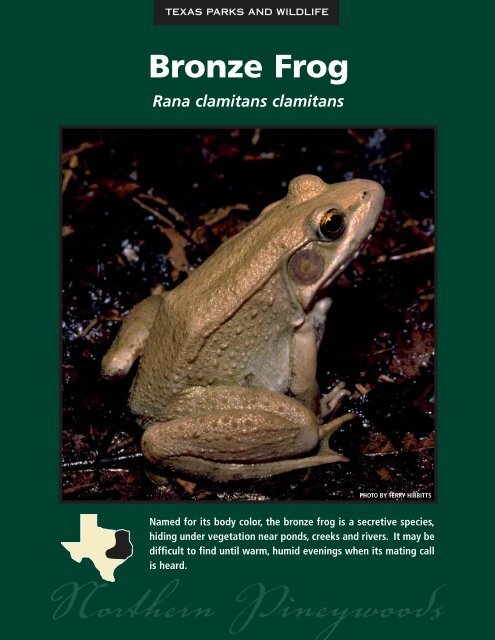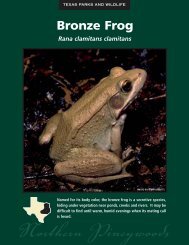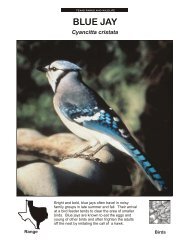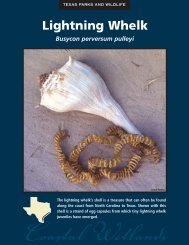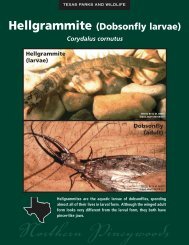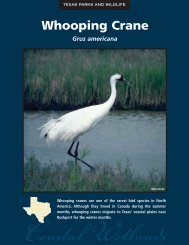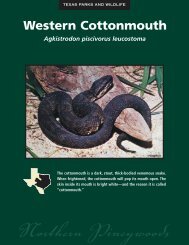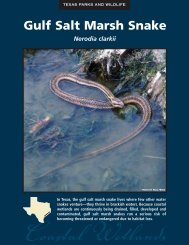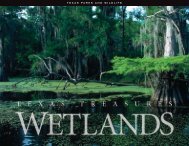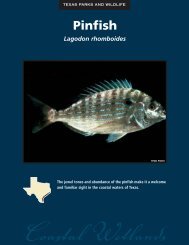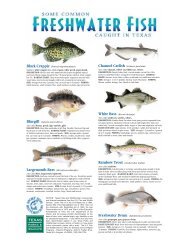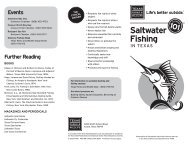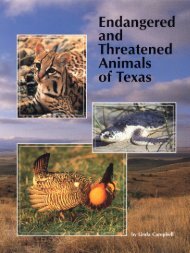Print Northern Pineywoods Species Fact Sheet Set - The State of ...
Print Northern Pineywoods Species Fact Sheet Set - The State of ...
Print Northern Pineywoods Species Fact Sheet Set - The State of ...
Create successful ePaper yourself
Turn your PDF publications into a flip-book with our unique Google optimized e-Paper software.
TEXAS PARKS AND WILDLIFEBronze FrogRana clamitans clamitansPHOTO BY TERRY HIBBITTSNamed for its body color, the bronze frog is a secretive species,hiding under vegetation near ponds, creeks and rivers. It may bedifficult to find until warm, humid evenings when its mating callis heard.
Bronze FrogRana clamitans clamitansAPPEARANCELength: 2 to 4 inches (5.4 to10.2 cm)Distinguishing Characteristics• Bronze to brownish body• White belly with dark, irregular blotches• Bright green upper lip and nose• Males may have yellowish throats.• Smooth skinned, like all true frogs• Long hind legs with webbed toes• Fold <strong>of</strong> skin, called a lateral line, begins behind the eye runstwo-thirds the length <strong>of</strong> body.• Tympanum (ear disc) is larger in males.LIFE HISTORYRange: Southeastern portion <strong>of</strong> the United<strong>State</strong>s, from North Carolina to the easternthird <strong>of</strong> TexasDiet: Small frogs, worms, insects, and othersmall invertebratesPredators: Birds, fish and small carnivores (meateaters)Sexual maturity: First full summer after metamorphosisBreeding season: Early spring through summerEggs: 2,000 to 4,000 eggs in small massesattached to underwater vegetation. Eggsare 1.5 mm when laid, but grow to6 mm as cells divide.Incubation: 1 to 2 weeksYoung: Tadpoles are green with small, darkspots. <strong>The</strong>y grow 1 to 1.5 inches (28 to33 mm) before they metamorphose(change from tadpoles to frogs).Life span: 7 to 10 yearsHABITATBronze frogs prefer shallow streams, ponds, marshes, springs,and swamps with plenty <strong>of</strong> vegetation.BEHAVIORBronze frogs are nocturnal and solitary. <strong>The</strong>y remain undercover, in logs and crevices, most <strong>of</strong> the time. Male bronze frogscourt females with a distinct call. Researchers agree that thelove song <strong>of</strong> the bronze frog sounds like someone plucking aloose banjo string. In fact, another common name for thebronze frog is the “banjo frog.”NOW YOU KNOW!• Rana is the Latin word for “frog.” Clamitans, the speciesand subspecies name, means “noisy” and refers to the call <strong>of</strong>the male.• <strong>The</strong> bronze frog is a member <strong>of</strong> the true frog family, theRanidae family.• <strong>The</strong> moist, permeable skin <strong>of</strong> the bronze frog (like other frogspecies) makes it very sensitive to pollution, a good indicator<strong>of</strong> water quality for people.BRONZE FROGS AND PEOPLE<strong>The</strong>re is concern about the decline in amphibian populationsworldwide, although there is not enough information aboutmost amphibians (bronze frogs included) in Texas to determinewhether there is cause for concern here. Worldwide, scientistsare investigating a number <strong>of</strong> possible causes for amphibiandecline: acid rain, herbicides, insecticides, fertilizers, industrialwaste, habitat destruction, introduced species, bacteria, ozonedepletion and global warming. It could be a combination <strong>of</strong> anyor several <strong>of</strong> these suspected causes. In Texas, citizens can joinTexas Amphibian Watch to help scientists keep an eye on thehealth <strong>of</strong> Texas amphibian populations.www.tpwd.state.tx.us/nature or call 512-912-7011PWD LF D0200-848A (8/02) NOTICE: Texas Parks and Wildlife Department receives federal financial assistance from the U.S. Fish and Wildlife Service. Under Title VI <strong>of</strong> the Civil Rights Act <strong>of</strong> 1964, Section 504 <strong>of</strong> the RehabilitationAct <strong>of</strong> 1973, Title II <strong>of</strong> the Americans with Disabilities Act <strong>of</strong> 1990, the Age Discrimination Act <strong>of</strong> 1975, and Title IX <strong>of</strong> the Education Amendments <strong>of</strong> 1972, the U.S. Department <strong>of</strong> the Interior and its bureaus prohibit discriminationon the basis <strong>of</strong> race, color, national origin, age, disability or sex (in educational programs). If you believe that you have been discriminated against in any Texas Parks and Wildlife Department program, activity, or facility, or if youdesire further information, please call or write: <strong>The</strong> U.S. Fish and Wildlife Service, Office for Diversity and Civil Rights Programs - External Programs, 4040 N. Fairfax Drive, Webb 300, Arlington, VA 22203, (703) 358-1724.
TEXAS PARKS AND WILDLIFEBald CypressTaxodium distichumTPWD PHOTOBald cypress trees add grace and beauty to many <strong>of</strong> Texas’ mostcherished waterways. A member <strong>of</strong> the Redwood family, they areamong the first trees in Texas to loose their leaves in the fall(hence the name “bald cypress”) and the last to bud in the spring.
Bald CypressTaxodium distichumAPPEARANCEHABITATHeight: Up to 120 feet (15.2 to 36.6m)Distinguishing Characteristics• Needle-like leaves grow individually from the twig.• Leaves are s<strong>of</strong>t and feathery in appearance.• Dull light green above, whitish underneath• Cone-shaped “knees” project from submerged roots.• Is a deciduous (looses its leaves in fall) conifer (conebearing tree)• Brown or gray bark with long fiber-like or scaly ridges thatpeel <strong>of</strong>f in strips• Cones are made up <strong>of</strong> several four-angled, flattened scales.• Limbs are <strong>of</strong>ten draped with Spanish moss (Tillandsiausneoides).Bald cypress are most abundant in wet, swampy soils <strong>of</strong>floodplain lakes and along riparian (streamside) corridors.BALD CYPRESS AND THEENVIRONMENT• Wild turkey, wood ducks, evening grosbeak and squirrels eatthe seeds.• Branches provide nesting places for bald eagles and osprey.• Rotting knees are used as nesting cavities by warblers.• Catfish spawn beneath cypress logs.• Bald cypress diffuse and slow floodwaters, reducing flooddamage. <strong>The</strong>y also trap sediments and pollutants.LIFE HISTORYBALD CYPRESS AND PEOPLERange:Flowers:Fruit:Seeds:Life span:Eastern states and west as far as centralTexasFlower buds appear in late December orearly January and bloom in March andApril. Pollen is shed, or released, whenthe flowers bloom.Seeds are produced inside the femalecone. <strong>The</strong> cones ripen from October toDecember, changing from green tobrownish purple, before dropping fromparent tree.Cones can contain anywhere from twoto 34 seeds, but generally average 16.Sprouts can form from the cut trunk <strong>of</strong>bald cypress trees as old as 60 years.Most live up to 600 years, but someindividuals have survived 1,200 years.<strong>The</strong> bald cypress is known by other names in parts <strong>of</strong> its range– Gulf cypress, red cypress, southern cypress, swamp cypress,white cypress and yellow cypress. Taxodium is Greek for “yewlike,”which refers to a family <strong>of</strong> generally small trees prized forhard wood. <strong>The</strong> species name, distichum, means “two-ranked”and refers to the two rows in which the leaves grow. Cypress isalso called the “wood eternal” because the heartwood is resistantto decay. Bald cypress is used for heavy construction, includingdocks, warehouses, boats and bridges, and was heavilylogged in much <strong>of</strong> Texas.<strong>The</strong> Choctaw Indians used the bark for string and rope. <strong>The</strong>Seminoles found bald cypress useful for making houses, canoes,and ceremonial objects.PWD LF D0200-848B (8/02) NOTICE: Texas Parks and Wildlife Department receives federal financial assistance from the U.S. Fish and Wildlife Service. Under Title VI <strong>of</strong> the Civil Rights Act <strong>of</strong> 1964, Section 504 <strong>of</strong> the RehabilitationAct <strong>of</strong> 1973, Title II <strong>of</strong> the Americans with Disabilities Act <strong>of</strong> 1990, the Age Discrimination Act <strong>of</strong> 1975, and Title IX <strong>of</strong> the Education Amendments <strong>of</strong> 1972, the U.S. Department <strong>of</strong> the Interior and its bureaus prohibit discriminationon the basis <strong>of</strong> race, color, national origin, age, disability or sex (in educational programs). If you believe that you have been discriminated against in any Texas Parks and Wildlife Department program, activity, or facility, or if youdesire further information, please call or write: <strong>The</strong> U.S. Fish and Wildlife Service, Office for Diversity and Civil Rights Programs - External Programs, 4040 N. Fairfax Drive, Webb 300, Arlington, VA 22203, (703) 358-1724.
TEXAS PARKS AND WILDLIFEFlierCentrarchus macropterusPHOTO BY KONRAD SCHMIDTFliers live in the quiet, acidic and dark-stained waters <strong>of</strong> EastTexas. <strong>The</strong>se little sunfish can put up a great fight when caughton an angler’s line.
FlierCentrarchus macropterusAPPEARANCEHABITATLength: 5 inches (12.7 cm), but can grow to 7 inches (17.8 cm)Weight: 3 ounces (85g)Distinguishing Characteristics• Olive-green back• Greenish-yellow to cream-colored sides with several rows <strong>of</strong>brown spots• Dark streak below each eye• Deep, round body• Wing-like fins, hence the common name “flier”• Anal fin (underside <strong>of</strong> fish in front <strong>of</strong> tail fin) almost equal insize to dorsal (back) finFliers prefer clear, acidic waters such as swamp ponds, sloughs,oxbows, slow-moving creeks and steams, with heavy vegetationand an average water temperature <strong>of</strong> 75º to 85º F (23º to 29º C).BEHAVIORMales guard eggs and newly hatched fry from intruders. Whenfrightened or alarmed, fliers seek refuge in aquatic vegetation,submerged tree roots or mats <strong>of</strong> floating vegetation. This reactionis part <strong>of</strong> what makes them such fighters, and why anglerssometimes like to fish for them.LIFE HISTORYNOW YOU KNOW!Range:Diet:Predators:Sexual maturity:Spawning season:Nests:Eggs:Young:Life span:Southeastern United <strong>State</strong>s and extremeEast TexasInsects, snails, worms, leeches, small fishand phytoplanktonLarger fish, turtles, snakes and wadingbirdsAt one yearIn March, when water temperaturesreach 62º to 68º F (16º to 20º C)Males construct disc-shaped nests byfanning their tails and removing silt anddebris from nest sites.20,000 to 35,000 eggsMales guard the nest until the younghatch. Juvenile fliers have a large darkspot encircled in orange on the s<strong>of</strong>t rays<strong>of</strong> the dorsal fin. <strong>The</strong> spot vanishes withage.Up to five years• Fliers are sometimes confused with black crappie becausethe size and shapes <strong>of</strong> small crappie are similar.• <strong>The</strong> flier is one <strong>of</strong> 174 freshwater fish species in Texas andone <strong>of</strong> 18 species <strong>of</strong> sunfish.FLIERS AND PEOPLESome people like to fish for fliers because their meat is sweetand good to eat while others like to keep fliers in large aquariumsbecause <strong>of</strong> their beauty. It is speculated that fliers havebeen accidentally introduced into small lakes and ponds outsidetheir native habitat when people release them from aquariums.Generally this is not a good practice, however scientists arewatching to see how these fish compete with native fish foravailable resources. In time, they will determine whether or notintroduced fliers will cause problems in their new habitats.PWD LF D0200-848C (8/02) NOTICE: Texas Parks and Wildlife Department receives federal financial assistance from the U.S. Fish and Wildlife Service. Under Title VI <strong>of</strong> the Civil Rights Act <strong>of</strong> 1964, Section 504 <strong>of</strong> the RehabilitationAct <strong>of</strong> 1973, Title II <strong>of</strong> the Americans with Disabilities Act <strong>of</strong> 1990, the Age Discrimination Act <strong>of</strong> 1975, and Title IX <strong>of</strong> the Education Amendments <strong>of</strong> 1972, the U.S. Department <strong>of</strong> the Interior and its bureaus prohibit discriminationon the basis <strong>of</strong> race, color, national origin, age, disability or sex (in educational programs). If you believe that you have been discriminated against in any Texas Parks and Wildlife Department program, activity, or facility, or if youdesire further information, please call or write: <strong>The</strong> U.S. Fish and Wildlife Service, Office for Diversity and Civil Rights Programs - External Programs, 4040 N. Fairfax Drive, Webb 300, Arlington, VA 22203, (703) 358-1724.
TEXAS PARKS AND WILDLIFECommon Green DarnerAnax juniusTPWD PHOTODragonflies haven’t changed much over the last 300 millionyears. Today they are one <strong>of</strong> the most easily recognized <strong>of</strong> allinsects. <strong>The</strong> common green darner is the largest, most abundantand widespread dragonfly species in North America.
Common Green DarnerAnax juniusAPPEARANCELength: 3 inches (7.6cm)Wingspan: 4.5 inches (11.4cm)Distinguishing Characteristics• Green head and thorax• Abdomen is yellow and brown on females; long, slender andbluish on males• Large compound eyes• Strong jaws• Spiny legs• Wings clear with yellowish tint toward tips and stronglyveined with net-like patternLIFE HISTORYRange: North America, the West Indies andSouth AmericaDiet: Larvae eat fish eggs, tadpoles and othersmall aquatic animals. Adults eat wasps,butterflies, mosquitoes and other flyinginsects (including other dragonflies).Predators: Larvae are eaten by fish, turtles, frogsand wading birds. Adults are eaten bybirds, fish and frogs.Sexual maturity: Two to three months after emerging asadult dragonfliesEggs: Laid one at a time in aquatic vegetationIncubation: <strong>The</strong> eggs hatch in the spring.Young: During the larval stages, generally lastingtwo to three years, the nymphs(aquatic larvae) pass through 11 to 12larval stages before metamorphosinginto dragonflies. Once they emerge asadults, they immediately begin the cycleagain.Life span: A few years in larval form, only four toseven weeks as adultsHABITATCommon green darners prefer permanent and temporary ponds,lakes, bays, estuaries and slow-moving streams and riparianareas (land adjacent to a body <strong>of</strong> water).BEHAVIORDuring the reproductive stage, the common green darner seeksfresh water ponds. Males return first, then females who havealready developed a batch <strong>of</strong> eggs. If the female is receptive,mating begins. <strong>The</strong>y <strong>of</strong>ten mate in flight. Immediately after mating,common green darner females lay their eggs, one at a time,in tiny slits in submerged aquatic plants. Males work hard toprotect their territories. Some have been clocked chasing intrudersaway at 35 miles per hour. Common green darners are one<strong>of</strong> the few dragonflies that migrate in the spring and fall.Scientists believe that they migrate with seasonal warm fronts.NOW YOU KNOW!• Most <strong>of</strong> a dragonfly’s brain is dedicated to processing andresponding to what they see. <strong>The</strong>ir complex eyes providenearly 360-degree vision.• Dragonflies can hover like a helicopter.• <strong>The</strong>y can exchange oxygen through specially adapted analchambers.COMMON GREEN DARNERSAND PEOPLECommon green darners are called “mosquito hawks” becausethey eat mosquitoes, providing an important service to humans.As an animal that lives in both freshwater and terrestrial (land)habitats, having healthy green darner populations indicates abalanced and healthy ecosystem.PWD LF D0200-848D (8/02) NOTICE: Texas Parks and Wildlife Department receives federal financial assistance from the U.S. Fish and Wildlife Service. Under Title VI <strong>of</strong> the Civil Rights Act <strong>of</strong> 1964, Section 504 <strong>of</strong> the RehabilitationAct <strong>of</strong> 1973, Title II <strong>of</strong> the Americans with Disabilities Act <strong>of</strong> 1990, the Age Discrimination Act <strong>of</strong> 1975, and Title IX <strong>of</strong> the Education Amendments <strong>of</strong> 1972, the U.S. Department <strong>of</strong> the Interior and its bureaus prohibit discriminationon the basis <strong>of</strong> race, color, national origin, age, disability or sex (in educational programs). If you believe that you have been discriminated against in any Texas Parks and Wildlife Department program, activity, or facility, or if youdesire further information, please call or write: <strong>The</strong> U.S. Fish and Wildlife Service, Office for Diversity and Civil Rights Programs - External Programs, 4040 N. Fairfax Drive, Webb 300, Arlington, VA 22203, (703) 358-1724.
TEXAS PARKS AND WILDLIFEFlathead CatfishPylodictis olivarisTPWD PHOTOAs the common name suggests, this catfish has a flat head, butother than that, it looks like any other catfish: it has smooth,scaleless skin, whisker-like barbels around the mouth, and long,sharp spines on the dorsal (back) fin and one on each side <strong>of</strong> thepectoral (shoulder) fin.
Flathead CatfishPylodictis olivarisAPPEARANCELength: 3 to 4 feet (0.9 to 1.2 m)Weight: Can exceed 100 pounds (45 kg)Distinguishing Characteristics• Olive-yellow to light brown body sometimes marked withdark specks or blotches• Belly is paler than the body.• Large mouth with protruding lower jaw• Eight barbels surround the mouth – four below the mouth,two above the mouth and one on each side <strong>of</strong> the mouth.• Square caudal (tail) finLIFE HISTORYRange:Diet:Predators:Sexual maturity:Spawning season:Nests:Eggs:Incubation:Young:Life span:From the lower Great Lakes through theMississippi River watershed to the GulfstatesYoung feed mostly on invertebrates suchas worms, insects and crayfish. When10 inches or larger, their diet consistsentirely <strong>of</strong> fish–shad, carp, suckers, sunfish,largemouth bass and other catfish(including their own kind).Alligators, water snakes, turtles, largerfish, and humansBetween the third and sixth yearLate May through August when thewater temperature is between 75º and80º FMales select hollow logs, caves or areasbeneath the banks for their nest sites.Males may even improve their selectedsites by creating shallow depressions forthe females to lay their eggs.Number varies greatly depending onfemale size, but average is up to100,000 eggs at a time.Four to six days<strong>The</strong> fry (very young fish) will schooltogether at the nest for several daysafter hatching; afterwards they will seekshelter beneath rocks, roots and othercover and begin their independent lives.Average is 12 to 14 years, but onerecorded flathead catfish lived 24 years.HABITATFlathead catfish prefer deep pools <strong>of</strong> streams, rivers, canals,lakes and reservoirs, where the water is turbid (cloudy) and thecurrents are slow.BEHAVIORAdults are usually solitary, each staking out a favorite spotunder a tree or in a cove, in deep water. At night, they moveinto shallow areas to feed. Males defend their nest and eggsaggressively. <strong>The</strong>y will fan the nest with their tails to keep theeggs clean and provide them with oxygenated water. If femaleshave been eating poorly, their bodies may conserve resources bynot releasing eggs. Poor overall health and certain environmentalconditions such as drought or flood can reduce flatheads’ability to spawn. In healthy times, clutches can reach 100,000eggs, but only a small number will survive.NOW YOU KNOW!• Catfish have long, sharp spines on the front edges <strong>of</strong> theirdorsal fins that are connected to venomous glands. Althoughthe spines can tear skin, the glands excrete venom. <strong>The</strong>venom is irritating and some people have had serious problemswith infection afterward. (If you are “stung” by a catfishand are worried about it, please call your doctor.)• Scientists estimate that a female will lay 1200 eggs for everypound she weighs. A female flathead that weights 50 poundsmight release 60,000 eggs at a time.• Pylodicitis is Greek for “mud fish.” Olivaris is Latin for“olive-colored.” Flathead catfish are known by other namesas well–yellow cat, opelousa cat, pied cat and Mississippi cat.• Unlike other catfish which are scavengers, flatheads preyonly on live fish.FLATHEAD CATFISH ANDPEOPLEIn size, flatheads are the second largest sport fish in Texas aftertheir cousin, the blue catfish. Among those who selectively fishfor catfish, flatheads fall just behind channel catfish as a prizedspecies. Because <strong>of</strong> their popularity with anglers, they havebeen introduced in many other states where they have adaptedwell. In some cases, however, they have out-competed thenative fish species, causing those native fish populations todecline sharply, disrupting some natural ecological processes.PWD LF D0200-848E (8/02) NOTICE: Texas Parks and Wildlife Department receives federal financial assistance from the U.S. Fish and Wildlife Service. Under Title VI <strong>of</strong> the Civil Rights Act <strong>of</strong> 1964, Section 504 <strong>of</strong> the RehabilitationAct <strong>of</strong> 1973, Title II <strong>of</strong> the Americans with Disabilities Act <strong>of</strong> 1990, the Age Discrimination Act <strong>of</strong> 1975, and Title IX <strong>of</strong> the Education Amendments <strong>of</strong> 1972, the U.S. Department <strong>of</strong> the Interior and its bureaus prohibit discriminationon the basis <strong>of</strong> race, color, national origin, age, disability or sex (in educational programs). If you believe that you have been discriminated against in any Texas Parks and Wildlife Department program, activity, or facility, or if youdesire further information, please call or write: <strong>The</strong> U.S. Fish and Wildlife Service, Office for Diversity and Civil Rights Programs - External Programs, 4040 N. Fairfax Drive, Webb 300, Arlington, VA 22203, (703) 358-1724.
TEXAS PARKS AND WILDLIFELouisiana Milk SnakeLampropeltis triangulum amauraPHOTO BY TERRY HIBBITTS<strong>The</strong> Louisiana milk snake is one <strong>of</strong> four coral snake-pretenders inTexas. Although non-venomous, Louisiana milk snakes look likehighly venomous coral snakes—they both have bands <strong>of</strong> black,red, and yellow.
Louisiana Milk SnakeLampropeltis triangulum amauraAPPEARANCELength: 16 to 24 inches (40 to 69 cm)Distinguishing Characteristics• Alternating bands, in order, <strong>of</strong> black-red-black-yellow-black.<strong>The</strong> red bands are solidly colored and are wider than the yellowor black bands.• Black head is slightly pointed.• Scales are shiny.BEHAVIORMilk snakes are secretive burrowers, hiding by day in loose,sandy soil, beneath objects on the ground or under the bark <strong>of</strong>tree trunks or logs. <strong>The</strong>y are nocturnal, or move above groundat night. <strong>The</strong> snakes’ coloring camouflages them particularlywell at night. Because they are cool-weather reptiles, theysuffer less from chilly temperatures. Unlike other snakes thatbecome lethargic at night and during the cool days <strong>of</strong> springand fall, Louisiana milk snakes move quickly and easily in cooltemperatures.LIFE HISTORYRange: Southwest Arkansas to southeastOklahoma and south through Louisianaand TexasDiet: Small snakes, small lizards and newbornmicePredators: Other snakes, bullfrogs, hawks and owls,skunks, raccoons and other mammalsSexual maturity: At two to three yearsMating season: SpringEggs: Two to 16, with an average clutch <strong>of</strong>nineNests: From early June through mid-July, thefemale lays her eggs inside a rotting log,beneath piles <strong>of</strong> plant material or insandy, well-drained soil.Incubation: 62 daysYoung: 5.5 to 8 inches (14 to 20 cm) and arepatterned and colored like their parentsLife span: One specimen lived for 20 years and 7months in captivity; the life span isshorter in the wild.HABITATLouisiana milk snakes prefer moist, sandy, low-lying woodedareas or beneath driftwood and other cover on the Gulf Coastbarrier islands.NOW YOU KNOW!• It is important to know the difference between Louisianamilk snakes and coral snakes. Coral snakes have red bandsbordered by yellow; milk snakes have red bands bordered byblack. It might be easier to remember this rhyme: Red toyellow, kill a fellow; Red to black, friend <strong>of</strong> Jack.• It was once believed that milk snakes mimicked, or lookedlike, coral snakes to avoid predators. But most snake-eatingmammals are colorblind and many predatory birds can probablysee color. <strong>The</strong> best explanation is that the body ringsserve to break up or disguise the body shape <strong>of</strong> the snake.LOUISIANA MILK SNAKESAND PEOPLEIn the old days, farmers <strong>of</strong>ten believed that milk snakes wereresponsible for cows drying up. <strong>The</strong>y thought that these snakeswould sneak into the barns under the cover <strong>of</strong> darkness andsuckle the cows dry. <strong>The</strong> discovery <strong>of</strong> a snake in the barn thefollowing day led to the farmer’s “logical” conclusion: the snakewas the guilty party. But, <strong>of</strong> course, snakes don’t drink cow’smilk. <strong>The</strong>y eat small reptiles and mammals. Besides, snakes haveteeth. Just imagine the cow’s reaction to a snake biting herudder! <strong>The</strong> commotion would surely have alerted the farmer tothe problem.In reality, Louisiana milk snakes are members <strong>of</strong> the king snakefamily, and as such, they seldom bite, although they may nip.Generally speaking, you should never disturb snakes in the wild,especially if you are unsure whether the snake in front <strong>of</strong> you isa coral snake or a Louisiana milk snake.PWD LF D0200-848F (8/02) NOTICE: Texas Parks and Wildlife Department receives federal financial assistance from the U.S. Fish and Wildlife Service. Under Title VI <strong>of</strong> the Civil Rights Act <strong>of</strong> 1964, Section 504 <strong>of</strong> the RehabilitationAct <strong>of</strong> 1973, Title II <strong>of</strong> the Americans with Disabilities Act <strong>of</strong> 1990, the Age Discrimination Act <strong>of</strong> 1975, and Title IX <strong>of</strong> the Education Amendments <strong>of</strong> 1972, the U.S. Department <strong>of</strong> the Interior and its bureaus prohibit discriminationon the basis <strong>of</strong> race, color, national origin, age, disability or sex (in educational programs). If you believe that you have been discriminated against in any Texas Parks and Wildlife Department program, activity, or facility, or if youdesire further information, please call or write: <strong>The</strong> U.S. Fish and Wildlife Service, Office for Diversity and Civil Rights Programs - External Programs, 4040 N. Fairfax Drive, Webb 300, Arlington, VA 22203, (703) 358-1724.
TEXAS PARKS AND WILDLIFELargemouth BassMicropterus salmoidesTPWD PHOTOTwo subspecies <strong>of</strong> largemouth bass exist in Texas: the nativeMicropterus salmoides salmoides and the Florida largemouthbass, Micropterus salmoides floridanus, which has beenintroduced into many Texas lakes.
Largemouth BassMicropterus salmoidesAPPEARANCELength: Adult average around 14 inches (35.5 cm)Weight: Adult average around 4 or 5 pounds (2.3 kg)Distinguishing Characteristics• Greenish with dark blotches forming a horizontal stripealong the middle <strong>of</strong> the fish on either side• Underside ranges in color from light green to almost white.• Nearly divided dorsal fin with the anterior portion containingnine spines and the posterior portion containing 12 to13 s<strong>of</strong>trays• Upper jaw reaches far beyond the rear margin <strong>of</strong> the eye.LIFE HISTORYRange: Native to the mid-west and southeastUnited <strong>State</strong>s and north central Mexico,including many rivers and lakes in TexasDiet: Fry (young) feed primarily on zooplanktonand insect larvae. Adults feed almostexclusively on other fish and large invertebratessuch as crayfish.Predators: Larger fish prey upon smaller bass.Except for humans, adult largemouthbass are the top predators in the aquaticecosystem.Sexual maturity: At two to three yearsSpawning season: Between February and May, dependingon locationNests: Males build the nests in two to eightfeet <strong>of</strong> water. <strong>The</strong>y prefer to nest inquieter, more vegetated water thanother black bass, but will use anysubstrate besides s<strong>of</strong>t mud, includingsubmerged logs.Eggs: 2,000 to 43,000Incubation: Five to ten daysYoung: Fry remain in a group or“school” near the nestand under the male’swatch for several daysafter hatching.Life span: Average 16 yearsHABITATLargemouth bass seek protective cover such as logs, rockledges, vegetation, and man-made structures. <strong>The</strong>y prefer clearquiet water, but will survive quite well in a variety <strong>of</strong> habitats.BEHAVIORImmature largemouth bass may tend to congregate in schools,but adults are usually solitary. Sometimes several bass will gatherin a very small area, but they do not interact. After breeding,males will chase the females away and guard the eggs and thefry himself. Largemouth bass hide among plants, roots or limbsto strike their prey.NOW YOU KNOW!• At about two inches in length, largemouth bass becomeactive predators.• Largemouth bass grow 4 to 6 inches (10 to 15 cm) duringtheir first year, 8 to 12 inches (20 to 30 cm) in two years,16 inches (40 cm) in three years.LARGEMOUTH BASS ANDPEOPLE<strong>The</strong> largemouth bass is by far the most sought-after fish inTexas. Because <strong>of</strong> the strong interest in largemouth bass fishing,there are hundreds <strong>of</strong> bass angling clubs in Texas devoted t<strong>of</strong>ishing and conservation. Bass fishing adds greatly to the Texaseconomy each year and largemouth bass are highly prized fortheir value as food. Because <strong>of</strong> the species’ popularity, it hasbeen introduced into many waters in which it did not originallyoccur. As with nearly all aquatic species, pollution and droughtare the biggest threats to the largemouth bass population.PWD LF D0200-848G (8/02) NOTICE: Texas Parks and Wildlife Department receives federal financial assistance from the U.S. Fish and Wildlife Service. Under Title VI <strong>of</strong> the Civil Rights Act <strong>of</strong> 1964, Section 504 <strong>of</strong> the RehabilitationAct <strong>of</strong> 1973, Title II <strong>of</strong> the Americans with Disabilities Act <strong>of</strong> 1990, the Age Discrimination Act <strong>of</strong> 1975, and Title IX <strong>of</strong> the Education Amendments <strong>of</strong> 1972, the U.S. Department <strong>of</strong> the Interior and its bureaus prohibit discriminationon the basis <strong>of</strong> race, color, national origin, age, disability or sex (in educational programs). If you believe that you have been discriminated against in any Texas Parks and Wildlife Department program, activity, or facility, or if youdesire further information, please call or write: <strong>The</strong> U.S. Fish and Wildlife Service, Office for Diversity and Civil Rights Programs - External Programs, 4040 N. Fairfax Drive, Webb 300, Arlington, VA 22203, (703) 358-1724.
TEXAS PARKS AND WILDLIFEFlowering DogwoodCornus floridaTPWD PHOTO<strong>The</strong> beautiful white bloom <strong>of</strong> the dogwood is one<strong>of</strong> the first signs <strong>of</strong> spring in East Texas forests.While pretty to look at, the flowering dogwoodprovides food for many <strong>Pineywoods</strong> animals.
TEXAS PARKS AND WILDLIFERafinesque’s Big-eared BatPlecotus rafinesquiiPHOTO BYBAT CONSERVATION INTERNATIONALRafinesque’s big-eared bats are one <strong>of</strong> the least known bats inthe southeastern United <strong>State</strong>s. Like all bats, big-eared batshelp make our lives more comfortable by eating millions <strong>of</strong> bugs,especially mosquitoes, every night. This bat uses its big ears andecholocation to help it find food.
TEXAS PARKS AND WILDLIFEPine WarblerDendroica pinusPHOTO BY VIREOPine warblers remain almost entirely within pine forests, bothduring the breeding season and through the winter. It is the onlybird in the forest with a bright yellow throat and white wing bars.
Pine WarblerDendroica pinusAPPEARANCEHABITATLength: 4.75 to 5.5 inches (12 to 14 cm)Wingspan: 9 inches (22 cm)Pine warblers prefer mature jack pine and pitch pine woodlands,mixed with hardwoods.Distinguishing Characteristics• Olive-colored back and upper wings• White wing bars• Yellow throat and breast• Small, active bird• Thin, pointed billsBEHAVIORPine warblers spend most <strong>of</strong> their time in pine forests, overwinteringin the southern United <strong>State</strong>s with a relatively shortmigration in the spring to more northern states. However, somepine warblers are permanent Texas residents.LIFE HISTORYRange: Eastern United <strong>State</strong>s, especially inpine forests, riparian areas and oakwoodlandsDiet: Insects, fruits and seedsPredators: Hawks and other birds <strong>of</strong> preySexual maturity: At one yearMating season: Mid-March through early JuneNests: Cup-shaped and made <strong>of</strong> bark strips,pine needles, twigs and other finematerial 25 to 40 feet (7.5 to 12.5 m)above ground near the branch tips <strong>of</strong>pine treesEggs: Three to five eggs, white with brownspotsIncubation: About ten daysYoung: <strong>The</strong> young are altricial (born with theireyes closed and bald), but they opentheir eyes, grow feathers and fledge allwithin about ten days <strong>of</strong> hatching.Life span: Less than five yearsNOW YOU KNOW!• <strong>The</strong> scientific name for this species describes its habitat:dendron (a tree); oicos (inhabitants); and pinus (a pinetree).• Pine warblers are among the most abundant warblers in theforest, able to adapt to different types <strong>of</strong> food available atdifferent times <strong>of</strong> year.• <strong>The</strong>ir more subdued coloring makes them more difficult tosee than some <strong>of</strong> the more brightly colored warblers.PINE WARBLERS AND PEOPLEAlthough not endangered now, good forest management willinsure that pine warblers will survive into the future. Pinewarblers will need forests with groups <strong>of</strong> pine trees andhardwoods and minimal human disturbance.PWD LF D0200-848J (8/02) NOTICE: Texas Parks and Wildlife Department receives federal financial assistance from the U.S. Fish and Wildlife Service. Under Title VI <strong>of</strong> the Civil Rights Act <strong>of</strong> 1964, Section 504 <strong>of</strong> the RehabilitationAct <strong>of</strong> 1973, Title II <strong>of</strong> the Americans with Disabilities Act <strong>of</strong> 1990, the Age Discrimination Act <strong>of</strong> 1975, and Title IX <strong>of</strong> the Education Amendments <strong>of</strong> 1972, the U.S. Department <strong>of</strong> the Interior and its bureaus prohibit discriminationon the basis <strong>of</strong> race, color, national origin, age, disability or sex (in educational programs). If you believe that you have been discriminated against in any Texas Parks and Wildlife Department program, activity, or facility, or if youdesire further information, please call or write: <strong>The</strong> U.S. Fish and Wildlife Service, Office for Diversity and Civil Rights Programs - External Programs, 4040 N. Fairfax Drive, Webb 300, Arlington, VA 22203, (703) 358-1724.
TEXAS PARKS AND WILDLIFE<strong>Northern</strong> FlickerColaptes auratusPHOTO BY VIREO<strong>The</strong> northern flicker is the only member <strong>of</strong> the woodpeckerspecies with a brown-colored back. It is the only woodpeckerthat feeds on the ground.
<strong>Northern</strong> FlickerColaptes auratusAPPEARANCEHeight: 12 to 13 inches (30 to 33 cm)Wingspan: 18 to 21 inches (45 to 53 cm)Distinguishing Characteristics• Gray-brown back with dark spots and a red crescent at thenape <strong>of</strong> the neck• Pale breast with black spots• Crescent-shaped patch at the base <strong>of</strong> the throat• White rump• Yellow breast and undersides <strong>of</strong> their wings (but red inwestern populations)• Downward curving bill• White rump patch flashes as it flies, hence, “flicker.”• Feeds on the groundLIFE HISTORYHABITATFlickers like woodlands, especially where dead or partially deadtrees for nesting sites can be found. <strong>Northern</strong> flickers tend toavoid unbroken or dense forests, preferring to forage for food inopen areas.BEHAVIOR<strong>Northern</strong> flickers are diurnal (most active during the daylighthours). Although diurnal, these birds tend to migrate at night,with weather determining both migration rates and departuredates. When mating, the males flash their bright bellies, breastsand rump patches, flap their wings, and swing their heads backand forth. <strong>Northern</strong> flickers will take advantage <strong>of</strong> an existingnest site or man-made nest boxes. Both parents contribute tonest construction and incubation.Range:Diet:Predators:Sexual maturity:Mating season:Nests:Eggs:Incubation:Young:Life span:<strong>The</strong> “yellow-shafted flicker” (yellowunder wings) migrates from Alaska toNicaragua. In parts <strong>of</strong> Texas, they areyear-round residents. <strong>The</strong> “red-shaftedflicker” (red under wings) migratesshorter distances.Ants and other insects, nuts, fruit andseedsRaccoons, feral cats, hawksOne yearFebruary through JulyExcavated in dead trees or deadportions <strong>of</strong> living trees, generally 6 to20 feet (1.8 to 6 m) above the ground,but as high as 100 feet (30 m); entranceto the nest is 2.75 inches (7 cm) indiameter.Usually five to eight11 to 16 daysYoung leave the nest about four weeksafter hatching. Under ideal conditions,two broods may be raised in oneseason.Up to 12 yearsNOW YOU KNOW!• <strong>The</strong> genus name Colaptes is from the Greek word colaptand means “peck,” which is, after all, what woodpeckers dobest.• <strong>The</strong> species, auratus, is from the Latin root aurat, meaning“gold” or “golden” and refers to its underwing.NORTHERN FLICKERSAND PEOPLEIn the Civil War (1860-1865), Confederate soldiers fromAlabama were called “Yellowhammers” because <strong>of</strong> the yellowcloth on their uniforms. It apparently reminded other soldiers <strong>of</strong>the underwings <strong>of</strong> “yellowhammers” or northern flickers.Once common across much <strong>of</strong> the United <strong>State</strong>s, northern flickerpopulations appear to be falling. Loss <strong>of</strong> suitable feeding andnesting sites due to logging and development are no doubtmaking an impact on this species. <strong>Northern</strong> flickers’ fondness <strong>of</strong>ants has created another problem—a number <strong>of</strong> them havedied after consuming ants contaminated with insecticides. Onenorthern flicker’s stomach contained almost 2,000 ants.PWD LF D0200-848K (8/02) NOTICE: Texas Parks and Wildlife Department receives federal financial assistance from the U.S. Fish and Wildlife Service. Under Title VI <strong>of</strong> the Civil Rights Act <strong>of</strong> 1964, Section 504 <strong>of</strong> the RehabilitationAct <strong>of</strong> 1973, Title II <strong>of</strong> the Americans with Disabilities Act <strong>of</strong> 1990, the Age Discrimination Act <strong>of</strong> 1975, and Title IX <strong>of</strong> the Education Amendments <strong>of</strong> 1972, the U.S. Department <strong>of</strong> the Interior and its bureaus prohibit discriminationon the basis <strong>of</strong> race, color, national origin, age, disability or sex (in educational programs). If you believe that you have been discriminated against in any Texas Parks and Wildlife Department program, activity, or facility, or if youdesire further information, please call or write: <strong>The</strong> U.S. Fish and Wildlife Service, Office for Diversity and Civil Rights Programs - External Programs, 4040 N. Fairfax Drive, Webb 300, Arlington, VA 22203, (703) 358-1724.
TEXAS PARKS AND WILDLIFESpotted GarLepisosteus oculatusTPWD PHOTO<strong>The</strong> spotted gar is one <strong>of</strong> three gar species native to Texas. Garare long and cylindrical with elongated mouths. <strong>The</strong>y areprimitive fish and date back to the Cretaceous period, some65 to 100 million years ago. <strong>The</strong> ancestors <strong>of</strong> spotted gar swamwith the dinosaurs!
Spotted GarLepisosteus oculatusAPPEARANCELength: 3 feet (0.9 m)Weight: 8 pounds (3.6 kg)Distinguishing Characteristics• Upper body brown to olive• Silver-white sides• Head, body, and fins have olive-brown to black spots thathelp camouflage the fish.• Broad, dark stripe on the sides <strong>of</strong> immature fish• Long, snout-like mouth lined with strong, sharp teeth• Thick, ganoid (diamond-shaped) scalesLIFE HISTORYRange:Diet:Predators:Sexual maturity:Spawning season:Eggs:Incubation:Young:Life span:From central Texas east into westernFlorida; extends north throughMississippi River drainage into Illinois,lower Ohio River, and the Lake EriedrainageFry feed primarily on insect larvae andtiny crustaceans, but fish appear on thediet <strong>of</strong> young gar very early. Prey is usuallyswallowed headfirst.Larger fish, alligators, herons, cottonmouthsnakesMales mature in two to three years.Females mature when three to fouryears old.From April to May<strong>The</strong> number varies greatly, but up toabout 20,000 green, adhesive eggs areattached to aquatic plants.Ten to 14 daysYoung gar have specialized pads ontheir upper jaws that allow them toadhere to vegetation. <strong>The</strong>y remainattached to plants until they are about0.75 inches (2cm) long. <strong>The</strong> pad is lostwhen last <strong>of</strong> the yolk sac is absorbed.Up to 18 yearsHABITATSpotted gar prefer quiet, vegetated waters <strong>of</strong> streams, swampsand lakes. <strong>The</strong>y sometimes enter brackish waters along theGulf Coast.BEHAVIORGar move slowly unless trying to catch food, which it grabs inits jaws in a quick sideways lunge. <strong>The</strong>y <strong>of</strong>ten bask near thewater’s surface on warm days. <strong>The</strong>y spawn in shallow waterwith low flow and heavy vegetation. Several males court asingle larger female at the same time.NOW YOU KNOW!• Gar have a specialized swim bladder which allows them togulp air and live in the poorly oxygenated back waters <strong>of</strong>Texas’ streams, swamps and lakes.• Lepisosteus is Greek and means “bony scale,” referring tothe large ganoid scales. Oculatus means “provided witheyes” in Latin and refers to the dark spots on head, body,and fins.• <strong>The</strong> common name, gar, is rooted in the Anglo-Saxonlanguage and means “spear.”• <strong>The</strong> roe (or egg mass) is highly toxic to humans, animalsand birds.SPOTTED GAR AND PEOPLEA large gar can eat a lot <strong>of</strong> fish, including catfish, causing themto compete with some anglers. Because <strong>of</strong> the competition andbecause many people think gar are difficult to clean, gar aresometimes called a “trash” fish. This term may not be warrantedwhen you consider that spotted gar, like all native species,have an important role to play in their ecosystem.PWD LF D0200-848M (8/02) NOTICE: Texas Parks and Wildlife Department receives federal financial assistance from the U.S. Fish and Wildlife Service. Under Title VI <strong>of</strong> the Civil Rights Act <strong>of</strong> 1964, Section 504 <strong>of</strong> the RehabilitationAct <strong>of</strong> 1973, Title II <strong>of</strong> the Americans with Disabilities Act <strong>of</strong> 1990, the Age Discrimination Act <strong>of</strong> 1975, and Title IX <strong>of</strong> the Education Amendments <strong>of</strong> 1972, the U.S. Department <strong>of</strong> the Interior and its bureaus prohibit discriminationon the basis <strong>of</strong> race, color, national origin, age, disability or sex (in educational programs). If you believe that you have been discriminated against in any Texas Parks and Wildlife Department program, activity, or facility, or if youdesire further information, please call or write: <strong>The</strong> U.S. Fish and Wildlife Service, Office for Diversity and Civil Rights Programs - External Programs, 4040 N. Fairfax Drive, Webb 300, Arlington, VA 22203, (703) 358-1724.
TEXAS PARKS AND WILDLIFESouthern Leopard FrogRana sphenocephalaTPWD PHOTOSouthern leopard frogs are very adaptable and are comfortablein many habitats—they just need cover and moisture. <strong>The</strong>se frogsare great jumpers, traveling high and far in just a few jumps.
Southern Leopard FrogRana sphenocephalaAPPEARANCELength: 2 to 3.5 inches (about 5 to 9 cm)Distinguishing Characteristics• Color varies from tan to several shades <strong>of</strong> brown to green.• Dorsum (back) is usually covered with irregular dark brownspots between distinct light colored areas.• Large dark spots on legs may create the effect <strong>of</strong> bands.• Light line along upper jaw• Light spot on tympanum (ear)• Slender with narrow, pointed head• Long hind legs and toes• Males are smaller than females, but with enlarged forearmsand thumbs and paired vocal sacs that look like balloonswhen inflated.LIFE HISTORYRange: Eastern United <strong>State</strong>s, from New Jerseyeast as far as Nebraska and Oklahomaand south into the eastern third <strong>of</strong> TexasDiet: Insects and small invertebratesPredators: Fish, raccoons, skunks and aquaticsnakesSexual maturity: First spring after hatchingBreeding: In Texas, breeding takes place yearround depending on temperature andmoisture.Eggs: Several hundred eggs are laid in acluster just below the water’s surface.Incubation: Seven to ten daysYoung: Newly hatched tadpoles are only about20 to 25 mm long. <strong>The</strong>y grow to 65 to70 mm before metamorphosing int<strong>of</strong>rogs, generally between 60 to 90 days.Life span: 3 yearsHABITATSouthern leopard frogs prefer shallow freshwater areas, but maybe seen some distance from water if there is enough vegetationand moisture to provide protection. Southern leopard frogs arealso able to live in brackish marshes along the coast.BEHAVIORSouthern leopard frogs elude predators by jumping into nearbywater and swimming underwater for some distance, while thepredator continues looking near the point <strong>of</strong> entry into thewater. <strong>The</strong>y are primarily nocturnal, hiding during the day invegetation at the water’s edge. During wet months, a leopardfrog may wander some distance from water, but stays in moistvegetation. <strong>The</strong>y will sometimes wander to colonize.NOW YOU KNOW!• <strong>The</strong> mating call is a series <strong>of</strong> abrupt, deep croaks, creating aguttural trill. <strong>The</strong> trill rate may be as many as 13 per second.• Males call from shore or while floating in shallow water.• A leopard frog’s mottled coloration helps camouflage it.• Southern leopard frogs are <strong>of</strong>ten used for teaching dissectingin science classes.SOUTHERN LEOPARD FROGSAND PEOPLE<strong>The</strong> name <strong>of</strong> the genus comes from the Latin rana (frog). <strong>The</strong>species name combines the Greek words sphenos (wedgeshaped)and kephale (head) to describe its triangular head. <strong>The</strong>mating calls <strong>of</strong> southern leopard frogs are a familiar backgroundsound to many Texans living near ponds, streams andwetlands. To obtain a tape <strong>of</strong> the calls <strong>of</strong> frogs and toads <strong>of</strong>Texas, contact Texas Parks and Wildlife Department, WildlifeDiversity Branch, 512-912-7011.PWD LF D0200-848N (8/02) NOTICE: Texas Parks and Wildlife Department receives federal financial assistance from the U.S. Fish and Wildlife Service. Under Title VI <strong>of</strong> the Civil Rights Act <strong>of</strong> 1964, Section 504 <strong>of</strong> the RehabilitationAct <strong>of</strong> 1973, Title II <strong>of</strong> the Americans with Disabilities Act <strong>of</strong> 1990, the Age Discrimination Act <strong>of</strong> 1975, and Title IX <strong>of</strong> the Education Amendments <strong>of</strong> 1972, the U.S. Department <strong>of</strong> the Interior and its bureaus prohibit discriminationon the basis <strong>of</strong> race, color, national origin, age, disability or sex (in educational programs). If you believe that you have been discriminated against in any Texas Parks and Wildlife Department program, activity, or facility, or if youdesire further information, please call or write: <strong>The</strong> U.S. Fish and Wildlife Service, Office for Diversity and Civil Rights Programs - External Programs, 4040 N. Fairfax Drive, Webb 300, Arlington, VA 22203, (703) 358-1724.
TEXAS PARKS AND WILDLIFESouthern CopperheadAgkistrodon contortrix contortrixTPWD PHOTOLying motionless on a bed <strong>of</strong> dead leaves, the pale-brown andchestnut-colored southern copperhead is all but invisible—aregular stealth viper! <strong>The</strong>se are venomous snakes, but they areslow-movers, and depending on the season, they <strong>of</strong>ten sharehabitats with their prey.
Southern CopperheadAgkistrodon contortrix contortrixAPPEARANCELength: 24 to 26 inches (60 to 66 cm)Distinguishing Characteristics• Pale brown to light tan body, <strong>of</strong>ten with a pinkish tint• Yellow eyes with elliptical or cat-like pupils• Dark, hour glass-shaped cross bands, wider at their base andnarrow across the back• Heat-sensing “pits” located between the eyes and nostrils,hence the name “pit viper”• Rough scalesLIFE HISTORYRange:Diet:Predators:Sexual maturity:Mating season:Eggs:Incubation:Young:Life span:Eastern United <strong>State</strong>s to central andsouthern states, and in the eastern third<strong>of</strong> TexasBaby cottontails, swamp rabbits, rats,mice, birds, snakes, lizards, baby turtles,frogs, toads and insects, especiallygrasshoppers and cicadasOther snakes and raptors (birds <strong>of</strong> prey)Males within two years, females in threeSpring (February to early May), shortlyafter leaving winter dens; and fall(August to October) with fertilizationdelayed until following springCopperheads, like other pit vipers, donot lay eggs. Instead the eggs are keptinside the female’s body until the eggsare ready to “hatch.”105 to 110 days<strong>The</strong> four to eight young, 7 to 10 inches(17 to 25 cm) long, weigh less than anounce (28 g) at birth. Although duller incolor, they look much like adults withyellowish tail-tips. (Tail-tips fade afterthird or fourth year.) Females provide noparental care after birth.One animal lived 23 years and 2 monthsin captivity, but in the wild, the averageis probably 6 to 8 years.HABITATSouthern copperheads prefer mixed pasture and woodedlowlands, usually within a river bottom, where leaf litter, logsand branches provide places to hide. <strong>The</strong>y are sometimes presentin wooded suburbs, adapting to the presence <strong>of</strong> humans.BEHAVIORSouthern copperheads are diurnal (active during daylighthours) during early spring and late fall, at which time they willgenerally depend on the ability <strong>of</strong> their bodies to blend in withtheir environment to obtain prey and avoid enemies. <strong>The</strong>y arenocturnal during the summer heat, actively hunting for preyduring the cooler evening hours. Southern copperheads <strong>of</strong>teneat one single meal every three weeks—even during their mostactive months. Copperheads sometimes nest with other snakespecies during hibernation.NOW YOU KNOW!• Some people believe that the bite <strong>of</strong> a baby venomous snakeis more powerful than that <strong>of</strong> an adult. Actually, there is nodifference in the venom’s potency, regardless <strong>of</strong> the age <strong>of</strong>the snake. Snake venom’s most important function is to killanimals to be eaten. Defense is only a secondary function.• Like all vipers, they use the “heat seeking pits” behind theireyes to help locate their prey.SOUTHERN COPPERHEADSAND PEOPLE<strong>The</strong> bite <strong>of</strong> a copperhead is seldom fatal because <strong>of</strong> its shortfangs (1.2 to 7.2 mm in length) and small amount <strong>of</strong> venom.Taking some simple safety precautions, however, can keep youfrom harm. Be careful where you put your hands and feet—don’t reach or step until you can see the bottom. Never stepover a log without first seeing what is on the other side. If youmust move a log, use a long stick or garden tool first to ensuresnakes are neither under, on or around these favored habitats.Use a flashlight when moving about at night, even in yourhome yard. Animal burrows make excellent habitat for snakes—don’t reach in without first checking. Wear protective clothing ifworking in areas where you suspect snakes nearby. Heavyfootwear, snake pro<strong>of</strong> trousers and/or leggings will help reduceyour risk. Freeze when snakes are known to be nearby until youknow where they are. Allow the snake to retreat. If you mustmove, back slowly and carefully away from the snake.PWD LF D0200-848O (8/02) NOTICE: Texas Parks and Wildlife Department receives federal financial assistance from the U.S. Fish and Wildlife Service. Under Title VI <strong>of</strong> the Civil Rights Act <strong>of</strong> 1964, Section 504 <strong>of</strong> the RehabilitationAct <strong>of</strong> 1973, Title II <strong>of</strong> the Americans with Disabilities Act <strong>of</strong> 1990, the Age Discrimination Act <strong>of</strong> 1975, and Title IX <strong>of</strong> the Education Amendments <strong>of</strong> 1972, the U.S. Department <strong>of</strong> the Interior and its bureaus prohibit discriminationon the basis <strong>of</strong> race, color, national origin, age, disability or sex (in educational programs). If you believe that you have been discriminated against in any Texas Parks and Wildlife Department program, activity, or facility, or if youdesire further information, please call or write: <strong>The</strong> U.S. Fish and Wildlife Service, Office for Diversity and Civil Rights Programs - External Programs, 4040 N. Fairfax Drive, Webb 300, Arlington, VA 22203, (703) 358-1724.
TEXAS PARKS AND WILDLIFERedfin ShinerLythrurus umbratilisPHOTO BY KONRAD SCHMIDT<strong>The</strong> redfin shiner is a member <strong>of</strong> the minnow family (Cyprinidae).Like other minnows, it is an important link in the food web <strong>of</strong>freshwater ecosystems, eating small insects and algae, thenbeing eaten by larger fish, wading birds and turtles.
Redfin ShinerLythrurus umbratilisAPPEARANCEBEHAVIORLength: 3.5 inches (8.9 cm) for average adultDistinguishing Characteristics• Light olive to steel blue body with silvery sides and anoccasional reddish tint in breeding males• Small dark spot at the base <strong>of</strong> the dorsal (back) fin• Large eyes• Blunt snoutLIFE HISTORYRange: Great Lakes and Mississippi Riverbasins, west New York to Minnesota andsouth to Louisiana and the Gulfdrainages west to the San Jacinto Riverin TexasDiet: Aquatic and terrestrial insects and othersmall animal life, occasionally algae andother plantsPredators: Larger fish, wading birds and humansSexual maturity: Between the second and third summerSpawning season: Late April through AugustNesting: Use nests previously used by sunfishEggs: Data not availableIncubation: Data not availableLife span: Up to 3 yearsHABITATRedfin shiners congregate in large schools near the water’s surface.<strong>The</strong>y are attracted to sunfish nests and are stimulated tospawn by the scent <strong>of</strong> fluids released from the sunfish duringspawning. A male redfin shiner will defend territory above asunfish nest until a female redfin comes along, then spawningoccurs.NOW YOU KNOW!• Redfin shiners can survive in water that is somewhat turbid(laden with silt) except during the breeding season, whenclear water is needed.• <strong>The</strong> term “minnow” is <strong>of</strong>ten used for any small fish, however,only members <strong>of</strong> the family “Cyprinidae” are true minnows.• Members <strong>of</strong> the Cyprinidae family include fish with commonnames such as minnow, shiner, chub, dace and stoneroller.• Goldfish and carp, both native to Asia, are also members <strong>of</strong>this family.• Texas has 56 native species in the Cyprinidae family, whileNorth America as a whole has 231 species.REDFIN SHINERS ANDPEOPLEPeople <strong>of</strong>ten use redfin shiners as bait to catch sportfish suchas crappie and bass. <strong>The</strong>y can also be used as a freshwateraquarium fish.Redfin shiners prefer pools and streams with sand and gravelbottoms and some vegetation.PWD LF D0200-848P (8/02) NOTICE: Texas Parks and Wildlife Department receives federal financial assistance from the U.S. Fish and Wildlife Service. Under Title VI <strong>of</strong> the Civil Rights Act <strong>of</strong> 1964, Section 504 <strong>of</strong> the RehabilitationAct <strong>of</strong> 1973, Title II <strong>of</strong> the Americans with Disabilities Act <strong>of</strong> 1990, the Age Discrimination Act <strong>of</strong> 1975, and Title IX <strong>of</strong> the Education Amendments <strong>of</strong> 1972, the U.S. Department <strong>of</strong> the Interior and its bureaus prohibit discriminationon the basis <strong>of</strong> race, color, national origin, age, disability or sex (in educational programs). If you believe that you have been discriminated against in any Texas Parks and Wildlife Department program, activity, or facility, or if youdesire further information, please call or write: <strong>The</strong> U.S. Fish and Wildlife Service, Office for Diversity and Civil Rights Programs - External Programs, 4040 N. Fairfax Drive, Webb 300, Arlington, VA 22203, (703) 358-1724.
TEXAS PARKS AND WILDLIFEYellow-billed CuckooCoccyzus americanusTPWD PHOTOThis shy, slender bird gets its name from the s<strong>of</strong>t coo-coo-coocoocall <strong>of</strong> the male seeking mates. In some places, it is calledthe “rain crow” or the “storm crow” because it begins callingright before the summer rains begin.
Yellow-billed CuckooCoccyzus americanusAPPEARANCELength: 10.5 to 12.5 inches (26 to 32 cm)Wingspan: 17 inches (43 cm)Distinguishing Characteristics• Lower mandible (bill) is yellow• Black upper bill that curves slightly downward• Head, neck, back and upper wings brown• Chin, breast and belly white• Two columns <strong>of</strong> large white spots on the under side <strong>of</strong>the tail• Long, slender tail• Two toes point forward, the other two point backward.LIFE HISTORYRange:Diet:Predators:Sexual maturity:Mating season:Nests:Eggs:Incubation:Chicks:North, Central and South America;migrates to North America throughoutthe summer months, but winters inSouth America; in Texas from Aprilthrough NovemberInsects (especially hairy caterpillars andcicadas) bird eggs, snails, small frogs,lizards, berries and some fruitEgg predators such as raccoons andjays; fledglings sometimes eaten byraptorsSpringMid-April through mid-September,peaking in MaySaucer-shaped and flimsy, nests aremade <strong>of</strong> twigs and lined with roots anddried leaves, 4 to 8 feet (1 to 2.5 m)above the ground.Two to four light blue eggs, about1.2 inches (31mm) longNine to 11 days<strong>The</strong> chicks are altricial (they hatchhelpless, blind, and featherless). Within aweek <strong>of</strong> hatching, the chicks can climbinto branches and within three weeks,they can fly.HABITATYellow-billed cuckoos prefer open woodlands with dense undergrowth,overgrown orchards and pastures, moist thickets andwillow groves along stream banks.BEHAVIORBecause they spend winters in mature tropical forests in SouthAmerica, they are one <strong>of</strong> the last migratory bird species toarrive in North America. <strong>The</strong>y arrive so late that they have littletime to build a nest, select a mate, lay eggs and raise theiryoung. Cuckoos mate with one partner a year. <strong>The</strong> male courtsthe female by <strong>of</strong>fering her sticks and other nest buildingmaterials. If the female seems receptive, the male will land onher shoulders and place a piece <strong>of</strong> food in her mouth. Egglaying is timed to occur when caterpillars and other invertebrateprey are most abundant. If food is abundant, the cuckoos willlay more eggs, and they will sometimes use other birds’ nests.This is called “nest parasitism.” <strong>The</strong> male takes care <strong>of</strong> the firstfledgling and the female cares for the rest.NOW YOU KNOW!• <strong>The</strong> bellow-billed cuckoo’s closest relative is the roadrunner.• Feathers account for almost half <strong>of</strong> the yellow-billed cuckoo’sbody weight.• Coccyz is Greek for a “cuckoo” and americanus is the Latinform meaning “<strong>of</strong> America.” Its scientific name means“cuckoo <strong>of</strong> America.”YELLOW-BILLED CUCKOOSAND PEOPLESome destruction <strong>of</strong> both its breeding grounds in North Americaand its wintering habitat in South America is limiting theyellow-billed cuckoo. Each year, it has fewer safe placesto raise young and to rest and rebuild energy for the longmigration to and from its breeding grounds. Few species cansurvive this double threat. Planting willow and cottonwoodsaplings, increasing woodland density, could revitalize feedingand nesting sites <strong>of</strong> the yellow-billed cuckoo.PWD LF D0200-848R (8/02) NOTICE: Texas Parks and Wildlife Department receives federal financial assistance from the U.S. Fish and Wildlife Service. Under Title VI <strong>of</strong> the Civil Rights Act <strong>of</strong> 1964, Section 504 <strong>of</strong> the RehabilitationAct <strong>of</strong> 1973, Title II <strong>of</strong> the Americans with Disabilities Act <strong>of</strong> 1990, the Age Discrimination Act <strong>of</strong> 1975, and Title IX <strong>of</strong> the Education Amendments <strong>of</strong> 1972, the U.S. Department <strong>of</strong> the Interior and its bureaus prohibit discriminationon the basis <strong>of</strong> race, color, national origin, age, disability or sex (in educational programs). If you believe that you have been discriminated against in any Texas Parks and Wildlife Department program, activity, or facility, or if youdesire further information, please call or write: <strong>The</strong> U.S. Fish and Wildlife Service, Office for Diversity and Civil Rights Programs - External Programs, 4040 N. Fairfax Drive, Webb 300, Arlington, VA 22203, (703) 358-1724.
TEXAS PARKS AND WILDLIFEWestern CottonmouthAgkistrodon piscivorus leucostomaTPWD PHOTO<strong>The</strong> cottonmouth is a dark, stout, thick-bodied venomous snake.When frightened, the cottonmouth will pop its mouth open. <strong>The</strong>skin inside its mouth is bright white—and the reason it is called“cottonmouth.”
Western CottonmouthAgkistrodon piscivorus leucostomaAPPEARANCELength: Most adults average 30-42 inches (76-106.7 cm)Distinguishing Characteristics• Dark, grayish-brown with little or no markings; very oldcottonmouths may be entirely black• White skin inside their mouth• Broad, flat head distinctly wider than neck• Elliptical (cat-like) pupil. By day the pupil appears as a narrowslit; at night the pupil is wide and may even look round.LIFE HISTORYRange:Diet:Predators:Sexual maturity:Mating season:Eggs:Incubation:Young:Life span:Southern Illinois south to Alabama, westto Oklahoma and Central TexasFrogs, fish, smaller snakes (includingother cottonmouths), small water birdsand small mammals, carrion and sometimesfish on stringersOther snakes and humansFemales at three years; males at two yearsSpringCottonmouths, like other pit vipers, donot lay eggs. Instead the eggs are keptinside the female’s body until the eggsare ready to “hatch.”Because fertilization and pregnancy arebased on the female’s physical condition,gestation periods vary from snaketo snake and season to season.Cottonmouths are born from earlyAugust until early October.Females bear only three to 12 <strong>of</strong>fspringper litter. Newborn cottonmouths are 6to 11 inches (15.2 to 28 cm) long. <strong>The</strong>yhave brownish or reddish bodies withlines that are wide on the sides and narrowacross the back. Cottonmouths areborn with yellow or greenish-gray tailtips and come complete with functionalfangs and a full supply <strong>of</strong> venom. DONOT TOUCH a young cottonmouth!Less than ten yearsHABITATWestern cottonmouths prefer lowland swamps, lakes, rivers,sloughs, irrigation ditches, rice fields and salt marshes, but arenot confined to living in moist habitats.BEHAVIOR• When swimming, the cottonmouth holds its head abovewater with most <strong>of</strong> its body barely touching the surface.• Cottonmouths are nocturnal, most active at night.• <strong>The</strong> young wiggle their tails so that the tip appears to be asmall worm. When small frogs and lizards see the wrigglingtail, they think it’s something to eat and rush forward to eatit, only to be eaten by the baby cottonmouth.• Cottonmouths eat other snakes, including their own kind. <strong>The</strong>only time more than one cottonmouth would be in the sameplace at the same time is: 1) mating season, 2) female givingbirth, or 3) one cottonmouth is eating another.NOW YOU KNOW!• Also called ‘water moccasin,” cottonmouths CAN bite underwater,but their prey is fish. If they could not bite underwater,they would starve.• Cottonmouths avoid contact with humans or any other possiblepredator. (All those stories about swarming cottonmouthsattacking people are myths!) But like any animal, whenthreatened, cottonmouths will attack to protect themselves.• In some places, especially around woodland ponds, you canfind western cottonmouths every few yards. Sometimes, youcan smell their musky odor in the air.• Heat sensors on either side <strong>of</strong> the snake’s face detect heatand help the cottonmouth to find food.WESTERN COTTONMOUTHSAND PEOPLEOnly 7% <strong>of</strong> all Texas snakebite cases involve cottonmouths.Throughout the United <strong>State</strong>s, less than 1% <strong>of</strong> all deaths bysnakebite have been caused by cottonmouths. While the oddsmake it seem unlikely to die from a cottonmouth bite, nonetheless,their venom can still cause severe bleeding and considerabledamage to tissue. DO NOT TOUCH and if bitten, seekimmediate medical attention!As our population continues to grow, and wildlife habitat isdeveloped, encounters with venomous snakes are going tooccur. Many <strong>of</strong> these encounters occur around the home, withthe result that incidents <strong>of</strong> bites close to home are statisticallyhigh. Keep wood and brush piles, trash dumps and livestockpens as far as possible from the residence. When working inthese areas, exercise caution. Never put an arm or leg intosomething if you cannot see the bottom. Use a flashlightwhen moving about at night, even in your home yard. Animalburrows make excellent habitat for snakes—don’t reach inwithout first checking.PWD LF D0200-848T (8/02) NOTICE: Texas Parks and Wildlife Department receives federal financial assistance from the U.S. Fish and Wildlife Service. Under Title VI <strong>of</strong> the Civil Rights Act <strong>of</strong> 1964, Section 504 <strong>of</strong> the RehabilitationAct <strong>of</strong> 1973, Title II <strong>of</strong> the Americans with Disabilities Act <strong>of</strong> 1990, the Age Discrimination Act <strong>of</strong> 1975, and Title IX <strong>of</strong> the Education Amendments <strong>of</strong> 1972, the U.S. Department <strong>of</strong> the Interior and its bureaus prohibit discriminationon the basis <strong>of</strong> race, color, national origin, age, disability or sex (in educational programs). If you believe that you have been discriminated against in any Texas Parks and Wildlife Department program, activity, or facility, or if youdesire further information, please call or write: <strong>The</strong> U.S. Fish and Wildlife Service, Office for Diversity and Civil Rights Programs - External Programs, 4040 N. Fairfax Drive, Webb 300, Arlington, VA 22203, (703) 358-1724.
TEXAS PARKS AND WILDLIFETimber RattlesnakeCrotalus horridusTPWD PHOTOTimber rattlesnakes have wide heads and narrow necks—atypical distinction <strong>of</strong> all venomous snakes except coral snakes(Micrurus fulvius). Timber rattlers are the second largestvenomous snake in Texas and third largest in the United <strong>State</strong>s.
Timber RattlesnakeCrotalus horridusAPPEARANCELength: 36 to 40 inches (91 to 101 cm)Weight: 1.3 to 2 pounds (0.58 to 0.9 kg)Distinguishing Characteristics• Heavy, light yellow, gray or greenish-white body• Rust-colored strip along length <strong>of</strong> back• Black tail tipped with rattles• Yellow eyes with elliptical or cat-like pupils• Marked with 20-29 dark, V-shaped crossbars with jaggededges across backLIFE HISTORYRange: Upland woods and rocky ridges in theeastern United <strong>State</strong>s; the eastern third<strong>of</strong> TexasDiet: Rabbits, squirrels, rats, mice and occasionallybirds, other snakes, lizards and frogsPredators: Coyotes, bobcats, skunks, foxes, hawksand owls and snake-eating snakes suchas king snakes, indigo snakes and cottonmouthsSexual maturity: At three years for males and up to fouryears for femalesMating season: In early spring; only once every two tothree years for femalesEggs: Timber rattlers, like other pit vipers, donot lay eggs. Instead the eggs are keptinside the female’s body until the eggsare ready to “hatch.”Incubation: Estimated six monthsYoung: Litters consist <strong>of</strong> between five and 20young, which are 10 to17 inches long(25 to 43 cm). Young may remain neartheir mother for seven to ten days afterbirth, but no parental care is provided.Life span: Up to ten yearsHABITATTimber rattlesnakes prefer moist lowland forests and hilly woodlandsor thickets near permanent water sources such as rivers,lakes, ponds, streams and swamps where tree stumps, logs andbranches provide refuge.BEHAVIORAlthough diurnal (active during the day) during spring and fall,timber rattlesnakes become nocturnal (active at night) duringthe oppressive heat <strong>of</strong> the summer. <strong>The</strong>y will coil beside a fallentree or log and wait for their quick-moving prey to pass. Pitvipers can develop an appetite for certain prey—some spendtheir lives eating only birds or chipmunks while others will eat avariety <strong>of</strong> foods. <strong>The</strong>ir interest and appetite seems to be shapedby killing a particular prey early in life.Highly venomous, timber rattlesnakes are sometimes slow todefend themselves and rely on their ability to blend into theirsurroundings to avoid confrontation. <strong>The</strong>y seek to escape ratherthan risking danger and will remain silent, and if possible, willhide before revealing their position to a predator. Despite theirlarge size and reputation, they are difficult to provoke intorattling or biting. Still, it does happen. It is best not to take anychances with such a potentially deadly snake. If one is bitten,seek immediate medical attention.NOW YOU KNOW!• According to legend, one can tell the age <strong>of</strong> a rattlesnake bythe number <strong>of</strong> rattles present at the end <strong>of</strong> its tail. A babyrattlesnake is born with the first segment <strong>of</strong> its rattle, calleda “button.” As the snake grows (and with each molting <strong>of</strong> itsouter skin) an additional segment is added to its rattle.Younger snakes shed more <strong>of</strong>ten than older snakes, but onaverage, free-ranging snakes may molt three to six times ayear. Another clue to a snake’s age is its color: timber rattlersdarken as they age, and the darkest are old males.• <strong>The</strong> scientific name, Crotalus horridus, is formed from twoLatin words: crotalum, meaning “bell or rattle,” andhorridus, for “dreadful”–which makes reference to its venom.TIMBER RATTLESNAKESAND PEOPLEAlthough many timber rattlers meet their deaths at the hands<strong>of</strong> people or by automobiles, the fastest way to kill timber rattlesnakepopulations is by destroying or altering the places theyneed to hunt, hibernate and live. Today, every state inhabited bytimber rattlesnakes has laws protecting the species, includingTexas. In Texas, it is listed as a threatened species. This meansthat people cannot take, transport, have in their possession orsell timber rattlesnakes.PWD LF D0200-848V (8/02) NOTICE: Texas Parks and Wildlife Department receives federal financial assistance from the U.S. Fish and Wildlife Service. Under Title VI <strong>of</strong> the Civil Rights Act <strong>of</strong> 1964, Section 504 <strong>of</strong> the RehabilitationAct <strong>of</strong> 1973, Title II <strong>of</strong> the Americans with Disabilities Act <strong>of</strong> 1990, the Age Discrimination Act <strong>of</strong> 1975, and Title IX <strong>of</strong> the Education Amendments <strong>of</strong> 1972, the U.S. Department <strong>of</strong> the Interior and its bureaus prohibit discriminationon the basis <strong>of</strong> race, color, national origin, age, disability or sex (in educational programs). If you believe that you have been discriminated against in any Texas Parks and Wildlife Department program, activity, or facility, or if youdesire further information, please call or write: <strong>The</strong> U.S. Fish and Wildlife Service, Office for Diversity and Civil Rights Programs - External Programs, 4040 N. Fairfax Drive, Webb 300, Arlington, VA 22203, (703) 358-1724.
TEXAS PARKS AND WILDLIFESweetgumLiquidambar styracifluaPHOTO BY BRENT HOLUBECAs one <strong>of</strong> the most common hardwoods in southern forests, sunlovingsweetgum provides shade for smaller understory plantsand animals, while its leaves provide brilliant fall colors. It occursnaturally in the East Texas <strong>Pineywoods</strong> ecosystem, but has beenintroduced as a landscape tree in other parts <strong>of</strong> the state.
SweetgumLiquidambar styracifluaAPPEARANCEHABITATHeight: 80 to120 feet (24 to 36 m)Distinguishing Characteristics• Star-shaped leaf with 5 to 7 lobes• Dark green in spring and summer• Brilliant gold and orange in autumn• Thick, gray-brown, deeply furrowed bark• Conical shape in young trees and oval shape in mature treesLIFE HISTORYRange: Texas east to Florida and north toNew YorkGrowth habit: Early growth is very rapid, but the tree<strong>of</strong>ten falls behind other species aftermaturity.Flowers: March through May; very small greenblossomsFruit: Fruit are shaped like horny globes.At least 25 species <strong>of</strong> birds, varioussquirrels and chipmunks eat the fruit.Seeds: Trees begin to produce seeds after 20 or30 years and continue to bear seedsuntil about 150 years old. Seed balls,under the best conditions, may hold upto 56 seeds. Sweetgum stumps androots sprout easily, especially after thestem is killed, cut or heavily damaged.Sweetgum are found in bottomland hardwood and riparian(streamside) areas. Although it prefers moist soil, it is extremelyadaptable and will grow in dryer areas.SWEETGUM AND THEENVIRONMENT<strong>The</strong> genus, Liquidambar, can be found here and there all overthe <strong>Northern</strong> Hemisphere. <strong>The</strong>re are more than 20 species <strong>of</strong>sweetgum identified. A Liquidambar fossil found in Greenlandis more than 55 million years old. Sweetgum <strong>of</strong>ten grow inmixed stands with maple, box elder, and pine trees. Becausesweetgum is a fast growing, fairly disease resistant species, itadapts well to areas that have been disturbed and is sometimesused in reforestation projects.SWEETGUM AND PEOPLENative Americans used to chew the hardened resin from thebark <strong>of</strong> sweetgum trees obtained by peeling the bark andscraping <strong>of</strong>f the resin-like solid. This gum was used medicinallyas well as for chewing gum. <strong>The</strong>y also made various teas andmedicines to treat dysentery and diarrhea from bark and roots<strong>of</strong> sweetgum. It is reported to be excellent for healing wounds.<strong>The</strong> wood <strong>of</strong> the sweetgum is second only to oak in being usedfor furniture, wooden boxes, musical instruments, flooring, andcomposite products. It has been cultivated in North Americasince the 1680s.PWD LF D0200-848W (8/02) NOTICE: Texas Parks and Wildlife Department receives federal financial assistance from the U.S. Fish and Wildlife Service. Under Title VI <strong>of</strong> the Civil Rights Act <strong>of</strong> 1964, Section 504 <strong>of</strong> the RehabilitationAct <strong>of</strong> 1973, Title II <strong>of</strong> the Americans with Disabilities Act <strong>of</strong> 1990, the Age Discrimination Act <strong>of</strong> 1975, and Title IX <strong>of</strong> the Education Amendments <strong>of</strong> 1972, the U.S. Department <strong>of</strong> the Interior and its bureaus prohibit discriminationon the basis <strong>of</strong> race, color, national origin, age, disability or sex (in educational programs). If you believe that you have been discriminated against in any Texas Parks and Wildlife Department program, activity, or facility, or if youdesire further information, please call or write: <strong>The</strong> U.S. Fish and Wildlife Service, Office for Diversity and Civil Rights Programs - External Programs, 4040 N. Fairfax Drive, Webb 300, Arlington, VA 22203, (703) 358-1724.
TEXAS PARKS AND WILDLIFEGiant FloaterAnodonta grandisTPWD PHOTOGiant floaters are freshwater mussels,or bivalves (invertebrates with twoshells) that live on the bottom <strong>of</strong>freshwater streams, rivers, lakes andponds. As one <strong>of</strong> more than 50 species<strong>of</strong> freshwater mussels found in Texas,giant floaters are very widespread.
Giant FloaterAnodonta grandisAPPEARANCEShell length: (from anterior to posterior ends) up to 6 inches(17 cm)Distinguishing Characteristics• Outside color <strong>of</strong> shell varies from tan to light brown,greenish-brown and dark brown.• Inside color is pearly white, with a bluish, light pink orsalmon tint.• Concentric growth lines on outside <strong>of</strong> smooth shell• Toothless hinge• Prominent beak (raised area near the hinge)LIFE HISTORYHABITATGiant floaters settle in slow-moving steams or rivers and largeponds or lakes with a muddy or somewhat sandy bottom.BEHAVIORGiant floaters are filter feeders (eat tiny plants and animalsthat they filter out <strong>of</strong> the water taken in through their siphons).Although they remain fairly stationary, partly buried in themuddy or sandy bottoms <strong>of</strong> quiet streams and ponds, somebiologists speculate that giant floaters can generate gasses ortrap air bubbles inside their shells and float from one locationto another.Range:Diet:Predators:Sexual maturity:Spawning season:Eggs:Incubation:Young:Life span:Widespread across North America. InTexas, giant floaters occur in all majorriver drainage basins.Tiny aquatic plants and animalsRaccoons, turtles, water birds and fishspecies such as freshwater drumNot knownFrom August to April or MayNumber varies depending on age andhabitat conditions. Males release spermdirectly into the water. Females take thesperm in through their siphons.Eggs located on a female’s gills arefertilized and develop in a brood pouchuntil large enough to be released intothe water.<strong>The</strong> free-floating larval stage <strong>of</strong> developmentis called the glochidia stage.When the glochidia come in contactwith a particular fish species such aslongnose gar, redfin shiners, or commoncarp, they attach to the gills <strong>of</strong> the fishand live as parasites for several monthswithout harming the fish. When largeenough, the juveniles drop <strong>of</strong>f <strong>of</strong> the fishhost, find a good place to dig in, andbegin growing into adult mussels.Four to ten yearsNOW YOU KNOW!• Giant floaters have thin shells. Even large specimens are lightweight.• Some scientists speculate that mussel glochidia, which live asparasites on fish hosts, actually keep the fish from gettingother more harmful parasites.• Freshwater mussels are <strong>of</strong>ten the first species to vanish whenenvironmental conditions change or decline. Drought, floods,or pollutants can have an immediate and sometimes longlastingeffect on mussel populations. Finding healthy musselpopulations can mean a healthy aquatic environment forpeople and animals.GIANT FLOATERS ANDPEOPLEAs filter feeders, giant floaters will concentrate in their tissuesanything dissolved in the water, including chemicals, heavymetals and other contaminants. Scientists can examine musseltissue to check for many toxic chemical pollutants that areharmful to aquatic habitats and to people.Humans have harvested giant floaters and other freshwatermussels to use as fish bait.PWD LF D0200-848X (8/02) NOTICE: Texas Parks and Wildlife Department receives federal financial assistance from the U.S. Fish and Wildlife Service. Under Title VI <strong>of</strong> the Civil Rights Act <strong>of</strong> 1964, Section 504 <strong>of</strong> the RehabilitationAct <strong>of</strong> 1973, Title II <strong>of</strong> the Americans with Disabilities Act <strong>of</strong> 1990, the Age Discrimination Act <strong>of</strong> 1975, and Title IX <strong>of</strong> the Education Amendments <strong>of</strong> 1972, the U.S. Department <strong>of</strong> the Interior and its bureaus prohibit discriminationon the basis <strong>of</strong> race, color, national origin, age, disability or sex (in educational programs). If you believe that you have been discriminated against in any Texas Parks and Wildlife Department program, activity, or facility, or if youdesire further information, please call or write: <strong>The</strong> U.S. Fish and Wildlife Service, Office for Diversity and Civil Rights Programs - External Programs, 4040 N. Fairfax Drive, Webb 300, Arlington, VA 22203, (703) 358-1724.
TEXAS PARKS AND WILDLIFEHellgrammite (Dobsonfly larvae)Hellgrammite(larvae)Corydalus cornutusPHOTO BY B. M. DREESTEXAS A&M UNIVERSITYDobsonfly(adult)PHOTO BY B. M. DREESTEXAS A&M UNIVERSITYHellgrammites are the aquatic larvae <strong>of</strong> dobsonflies, spendingalmost all <strong>of</strong> their lives in larval form. Although the winged adultform looks very different from the larval form, they both havepincer-like jaws.
Hellgrammite (Dobsonfly larvae)Corydalus cornutusAPPEARANCELength: 2.75 inches (7 cm)Distinguishing Characteristics• Yellowish to brown• Stout, segmented, caterpillar-like bodies• Large pinching mandibles• Six legs on the thorax• Eight feathery appendages on the abdomen• Four claws at the rear <strong>of</strong> their abdomenLIFE HISTORYRange:Diet:Predators:Sexual maturity:Mating:Eggs:Incubation:Young:Life span:North AmericaAquatic insects and small invertebratesFish, frogs, other aquatic predatorsUp to three yearsImmediately after emergence frompupae stage as dobsonflies, from Aprilthrough MayUp to 3,000 in each egg mass. Eggs areproduced from May through August.Females lay circular egg masses at nighton rocks, leaves, trees, bridges and othersuitable sites that hang over water.When the egg masses dry, they lookchalky and white. Each female lays twoegg masses during her two-week longadult life.Two weeksAfter hatching, the larvae, hellgrammites,drop into water. Hellgrammiteshide under rocks in streams. <strong>The</strong>y canstay in this larval stage as long as fouryears, but usually only two to threeyears. Hellgrammites may shed theirexoskeletons as many as 12 timesbefore they emerge as pupae. <strong>The</strong> pupaecrawl several feet onto land and burrow2 to 4 inches (5 to 10 cm) into wet soils,moss, decaying vegetation or beneathrocks and logs. <strong>The</strong>y emerge as dobsonfliestwo weeks later.As hellgrammites, larvae live two tothree years. As dobsonflies, adults liveabout two weeks.HABITATHellgrammites are aquatic and live in the shallow, fast flowingportions <strong>of</strong> streams, creeks, and small rivers, hiding beneathrocks and logs.BEHAVIORHellgrammites are nocturnal (active at night). Hellgrammitesare also poor swimmers, but voracious predators. To catch prey,they hide under large rocks and other shelter in fast flowingstretches <strong>of</strong> streams, creeks and small rivers and attack prey asit swims or crawls past.NOW YOU KNOW!• <strong>The</strong> short-lived adult dobsonflies are among the largest flyinginsects in Texas.• Dobsonflies are reddish to grayish brown with stronglyveined wings and small white spots on their forewings. <strong>The</strong>yhave long, thin antennae. <strong>The</strong>ir bodies are about 5 inches(13 cm) long with a wingspan <strong>of</strong> 4 to 5 inches (10 to 13 cm).• Male dobsonflies have long, sickle-shaped, pincer-like jawsup to 1 inch (2.54cm) which are used to grasp femalesduring mating. Adult dobsonflies are terrestrial and seekshelter in tree canopies near water. <strong>The</strong>y hide by day underleaves, are weak fliers and are attracted to lights. <strong>The</strong>y arenocturnal.• Adult dobsonflies don’t eat, and after mating, they die.HELLGRAMMITES ANDPEOPLEHellgrammites make excellent fish bait and are <strong>of</strong>ten used assuch, especially for largemouth bass. But be extremely cautiouswhen handling hellgrammites because they bite. For that reason,they are also called “toe biters.”PWD LF D0200-848Y (8/02) NOTICE: Texas Parks and Wildlife Department receives federal financial assistance from the U.S. Fish and Wildlife Service. Under Title VI <strong>of</strong> the Civil Rights Act <strong>of</strong> 1964, Section 504 <strong>of</strong> the RehabilitationAct <strong>of</strong> 1973, Title II <strong>of</strong> the Americans with Disabilities Act <strong>of</strong> 1990, the Age Discrimination Act <strong>of</strong> 1975, and Title IX <strong>of</strong> the Education Amendments <strong>of</strong> 1972, the U.S. Department <strong>of</strong> the Interior and its bureaus prohibit discriminationon the basis <strong>of</strong> race, color, national origin, age, disability or sex (in educational programs). If you believe that you have been discriminated against in any Texas Parks and Wildlife Department program, activity, or facility, or if youdesire further information, please call or write: <strong>The</strong> U.S. Fish and Wildlife Service, Office for Diversity and Civil Rights Programs - External Programs, 4040 N. Fairfax Drive, Webb 300, Arlington, VA 22203, (703) 358-1724.
TEXAS PARKS AND WILDLIFEMarbled SalamanderAmbystoma opacumPHOTO BY PAUL FREED<strong>The</strong> marbled salamander is a lizard-like amphibian that is seldomseen by people. One reason is that they are nocturnal (active atnight), and hide by day under vegetation and rotten logs. Like allamphibians, they require water to complete their life cycle,surviving dry times by burrowing deep into the soil.
Marbled SalamanderAmbystoma opacumAPPEARANCELength: 4 to 5 inches (10 to 12.7 cm) head and bodyDistinguishing Characteristics• Dark gray to black or even deep purple above with a graybelly• Light silver to white markings on back• Stocky body with short, broad head• Relatively short tail for a salamander – tail 40% total length• Short legs with four toes on forelegs and five toes on hindlegsLIFE HISTORYRange: Eastern half <strong>of</strong> the United <strong>State</strong>s andthroughout East Texas from Red Riversouth to the Gulf <strong>of</strong> MexicoDiet: Earthworms and small insects; duringthe larval stages they feed on zooplankton,but as they grow, they graduallybegin to feed on small insects (includingmosquitoes), tadpoles and other larvae.Predators: Snakes, raccoons, ducks and wadingbirdsMating season: Throughout fallNests: Shallow, dry depressions in pond orstream banksEggs: 50 to 200 eggsIncubation: Eggs hatch as soon as they are coveredwith water, but may delay until spring ifrainfall is insufficient to cover them.Young: Larvae are about 0.75 inch (2 cm) longwhen hatched and metamorphose(change from larvae to adult) in four tosix months.Life span: Four yearsHABITATMarbled salamanders prefer riparian areas (land adjacent towater) or swampy areas with slow moving water. <strong>The</strong>y canusually be found under rotting logs and other vegetation.BEHAVIORMale marbled salamanders breed near water. <strong>The</strong>y emergeduring winter rains and enter shallow pools to deposit spermpackets. <strong>The</strong> females arrive later, pick up the packets andfertilize their eggs internally, storing them until it is time to laytheir clutch (group <strong>of</strong> eggs). <strong>The</strong> females select a point betweenthe shallowest and deepest area <strong>of</strong> the ponds. <strong>The</strong>n they laytheir eggs one at a time in a shallow depression under vegetation,encircling the eggs until the depression fills with waterfrom spring rains. This behavior is called brooding the eggs.NOW YOU KNOW!• Young are generally brown to black with light spots ormottling dorsally (on top) and laterally (on sides).Marbled salamanders darken as they mature.• <strong>The</strong>re are 24 salamander species in Texas.• Salamanders are <strong>of</strong>ten mistaken for lizards, but they havesmooth or warty skin instead <strong>of</strong> scales and have no clawson their feet.MARBLED SALAMANDERSAND PEOPLEWorldwide, many amphibian populations are declining or havedisappeared completely. <strong>The</strong>re are many possible causes for thisdecline—acid rain, herbicides, insecticides, fertilizers, industrialwaste, habitat destruction, introduced species, bacteria, ozonedepletion, and global warming. Although the exact cause orcombination <strong>of</strong> causes for decline is still a mystery, scientists areworking to discover how to save the marbled salamander andother amphibians. People can help by recognizing and conservingsalamander habitat where possible and by supporting thestudy <strong>of</strong> local and global environmental change.PWD LF D0200-848L (2/03) NOTICE: Texas Parks and Wildlife Department receives federal financial assistance from the U.S. Fish and Wildlife Service. Under Title VI <strong>of</strong> the Civil Rights Act <strong>of</strong> 1964, Section 504 <strong>of</strong> the RehabilitationAct <strong>of</strong> 1973, Title II <strong>of</strong> the Americans with Disabilities Act <strong>of</strong> 1990, the Age Discrimination Act <strong>of</strong> 1975, and Title IX <strong>of</strong> the Education Amendments <strong>of</strong> 1972, the U.S. Department <strong>of</strong> the Interior and its bureaus prohibit discriminationon the basis <strong>of</strong> race, color, national origin, age, disability or sex (in educational programs). If you believe that you have been discriminated against in any Texas Parks and Wildlife Department program, activity, or facility, or if youdesire further information, please call or write: <strong>The</strong> U.S. Fish and Wildlife Service, Office for Diversity and Civil Rights Programs - External Programs, 4040 N. Fairfax Drive, Webb 300, Arlington, VA 22203, (703) 358-1724.
TEXAS PARKS AND WILDLIFERed-shouldered HawkButeo lineatusTPWD PHOTORed-shouldered hawks are medium-sized raptors with sharpeyes, broad strong wings and long legs. <strong>The</strong>y are effectivehunters, helping to maintain a balance <strong>of</strong> predators and prey inwoodland and grassland areas.
Red-shouldered HawkButeo lineatusAPPEARANCELength: 17 to 24 inches (43 to 61 cm)Females are slightly larger than males.Wingspan: 36 to 40 inches (91 to 101 cm)Distinguishing Characteristics• Reddish shoulders, rust-colored breast with white and darkstreaks• Long, narrow and blackish-brown wings with black andwhite stripes on the undersides• Long tails with narrow black and white bands and white tips• Translucent “window” patch on each wing at base <strong>of</strong>primary feathersLIFE HISTORYRange:Diet:Predators:Mating season:Nests:Eggs:Incubation:Chicks:Life span:HABITATSoutheastern Canada and easternUnited <strong>State</strong>s south to central Mexico.Some are permanent residents in theeastern third <strong>of</strong> Texas.Rabbits, rodents and other small mammals,as well as small birds, snakes,lizards, frogs, fish, insects and crayfishNest-raiding birds, snakes and mammals;humansLate January to June, peaking in Marchand early AprilCup-shaped and made <strong>of</strong> sticks, linedwith dried leaves, strips <strong>of</strong> bark, Spanishmoss, lichens, feathers and down;generally built between 20 and 60 feet(6 to 18 m) above groundTwo or three (occasionally one to six),white eggs marked with brown oryellowish-brown blotches28 to 33 daysAltricial (born blind and helpless), butleave the nest after 39 to 45 daysOne banded specimen lived almost20 years.Red-shouldered hawks prefer moist woodlands, such a bottomlandhardwood forests or deciduous or mixed forests borderinglakes, streams or other wetlands.BEHAVIORRed-shouldered hawks are diurnal (active during the day) andrest at night. <strong>The</strong>y watch for prey from low perches 6 to 15 feet(2 to 4.5 m) above the ground or by soaring above fields andmeadows near wooded areas. Perch sites are generally found intrees, but may also include utility poles, fence posts and haybales. Once prey is spotted, the hawks drop directly onto it fromabove. <strong>The</strong> red-shouldered hawk hunts by sight and smell, butnot by hearing. Nesting and hunting territories are usually0.25 to 1 mile (0.4 to 1.61 km) in size. <strong>The</strong> birds aggressivelydefend these areas during the spring when eggs are in the nest.<strong>The</strong> females incubate the eggs while the males hunt for them.Once the eggs have hatched, both parents hunt. <strong>The</strong> femalesare larger and hunt slower prey. <strong>The</strong> males are smaller andmore agile, hunting smaller and faster prey.NOW YOU KNOW!• <strong>The</strong> hawk’s eyes are situated to look forward. <strong>The</strong>y havebinocular vision, which helps them measure depth anddistance—and makes the bird a precise hunter.• Because <strong>of</strong> their wing structures, red-shouldered hawks cansoar for extended periods without tiring.• <strong>The</strong>ir call is a repeated kee-yeer. Red-shouldered and otherhawks are <strong>of</strong>ten used to lip-sync the cry <strong>of</strong> bald eagles in themovies and on television because their calls are more distinctivethan the eagle’s call.RED-SHOULDERED HAWKSAND PEOPLEFederal law protects all hawks and other birds <strong>of</strong> prey, whichinclude eagles, osprey, falcons, owls and vultures. It is illegal toharm or kill them or to own any parts <strong>of</strong> their bodies, such astalons (claws), feathers or nests. Nonetheless, humans <strong>of</strong>ten targethawks as potential predators <strong>of</strong> chickens and other domesticfowl.Before its use was outlawed in the United <strong>State</strong>s, red-shoulderedhawks and other raptors suffered from exposure to DDT, apesticide. <strong>The</strong> DDT would cause their eggs to have thin, breakableshells, reducing their ability to reproduce. Accidentalencounters with power lines and automobiles also take a toll onhawks. In spite <strong>of</strong> these dangers, habitat loss remains thebiggest threat to red-shouldered hawks.PWD LF D0200-848Q (2/03) NOTICE: Texas Parks and Wildlife Department receives federal financial assistance from the U.S. Fish and Wildlife Service. Under Title VI <strong>of</strong> the Civil Rights Act <strong>of</strong> 1964, Section 504 <strong>of</strong> the RehabilitationAct <strong>of</strong> 1973, Title II <strong>of</strong> the Americans with Disabilities Act <strong>of</strong> 1990, the Age Discrimination Act <strong>of</strong> 1975, and Title IX <strong>of</strong> the Education Amendments <strong>of</strong> 1972, the U.S. Department <strong>of</strong> the Interior and its bureaus prohibit discriminationon the basis <strong>of</strong> race, color, national origin, age, disability or sex (in educational programs). If you believe that you have been discriminated against in any Texas Parks and Wildlife Department program, activity, or facility, or if youdesire further information, please call or write: <strong>The</strong> U.S. Fish and Wildlife Service, Office for Diversity and Civil Rights Programs - External Programs, 4040 N. Fairfax Drive, Webb 300, Arlington, VA 22203, (703) 358-1724.
TEXAS PARKS AND WILDLIFEWhite-tailed DeerOdocoileus virginianusTPWD PHOTOBy the late 1930s, deer populations in many areas <strong>of</strong> the<strong>Pineywoods</strong> had disappeared, with remnant herds in a few remotebottomlands. Now, because <strong>of</strong> deer-stocking, enforcement <strong>of</strong>game laws and good habitat management on private lands, thepopulation has rebounded.
White-tailed DeerOdocoileus virginianusAPPEARANCEHeight: 32 inches to 36 inches (81.4 cm to 91.4 cm) atthe shoulderWeight: Females: 80 to140 pounds (36 to 63 kg)Males: 100 to 250 pounds (45.3 to 112.5 kg)Distinguishing Characteristics• Small to medium-sized deer; size somewhat dependent onavailability <strong>of</strong> food• Gray-brown with a reddish cast in the summer for both maleand female• Fawns have white spots on their backs and sides to helpcamouflage them.• Underside <strong>of</strong> the tail is white.• Four toes that are “fused” or modified into a ho<strong>of</strong> creating atwo-toed ho<strong>of</strong> printLIFE HISTORYRange:Diet:Predators:Sexual maturity:Mating season:Gestation:Number <strong>of</strong> young:Life span:HABITATMost <strong>of</strong> the United <strong>State</strong>s, except in theSouthwest, Alaska and HawaiiAcorns, pecans, western persimmons,live oak twigs and leaves, yaupon, sometypes <strong>of</strong> grasses and various floweringplantsCoyotes, mountain lions, bobcats anduncontrolled dogsAbout 2 years oldSeptember through December6.5 to 7 months<strong>The</strong> first baby is usually a single fawn.After that, most does tend to havetwins. About 60% <strong>of</strong> a deer’s bodygrowth takes place the first year <strong>of</strong> itslife. Long bone growth is complete atabout 3 years <strong>of</strong> age.Average life span <strong>of</strong> males is about6 years. Females live about 8 years. <strong>The</strong>record white-tailed deer was a doe inGeorgia that lived 22 years.White-tailed deer are found in the deep woods and riverbottoms <strong>of</strong> East Texas, the live oak and cedar thickets <strong>of</strong> CentralTexas, the brushy canyons <strong>of</strong> west and north-central Texas, andthe mesquite thickets and rangelands <strong>of</strong> South Texas. Deerrequire cover for safety from predators as well as open areas forbrowsing.BEHAVIORWhite-tailed deer do not migrate, but will remain in an areaabout 1 square kilometer in size year round. When threatened,deer will <strong>of</strong>ten remain motionless or will quickly escape if necessary.Deer hold up their tails like a flag, showing the whiteunderside when frightened. <strong>The</strong>y are very quiet animals, exceptwhen bucks call to does during the mating season and whendoes call to their fawns.NOW YOU KNOW!• Male deer begin growing their first set <strong>of</strong> antlers at aboutone year <strong>of</strong> age. When antlers first appear in spring, they arecovered with a s<strong>of</strong>t fuzzy skin called velvet that protects thegrowing bone and is rubbed <strong>of</strong>f by the deer when the growthis complete. <strong>The</strong>y will grow a new set <strong>of</strong> antlers yearly. Withproper nutrition, antlers will get larger each year until about6 years <strong>of</strong> age.• It is impossible to tell the age <strong>of</strong> deer by the size <strong>of</strong> theirantlers or the number <strong>of</strong> their points.• White-tailed deer are ruminants (have four stomachs) andcan pass food from one stomach to the next to get themaximum nutritional benefit from everything they eat.• White-tailed deer can make vertical leaps <strong>of</strong> up to 8.5 feet(2.6 m)WHITE-TAILED DEERAND PEOPLEWhite-tailed deer have adapted to living close to humandevelopment and at times create traffic hazards in suburbanneighborhoods. Some people like to feed deer and watch thembrowse in their yards, while others see them as pests who eattheir shrubbery and flowers. By allowing, encouraging andregulating hunting <strong>of</strong> white-tailed deer, we are able to minimizethe overpopulation <strong>of</strong> deer thereby preventing thousands <strong>of</strong>animals from starving and reducing hazards to humans.White-tailed deer are North American’s most popular and abundantgame animal. Many ranchers in Texas lease out land tohunters during deer hunting season. Hunting helps ranchersmanage the deer population and adds income to their ranchoperation.PWD LF D0200-848S (2/03) NOTICE: Texas Parks and Wildlife Department receives federal financial assistance from the U.S. Fish and Wildlife Service. Under Title VI <strong>of</strong> the Civil Rights Act <strong>of</strong> 1964, Section 504 <strong>of</strong> the RehabilitationAct <strong>of</strong> 1973, Title II <strong>of</strong> the Americans with Disabilities Act <strong>of</strong> 1990, the Age Discrimination Act <strong>of</strong> 1975, and Title IX <strong>of</strong> the Education Amendments <strong>of</strong> 1972, the U.S. Department <strong>of</strong> the Interior and its bureaus prohibit discriminationon the basis <strong>of</strong> race, color, national origin, age, disability or sex (in educational programs). If you believe that you have been discriminated against in any Texas Parks and Wildlife Department program, activity, or facility, or if youdesire further information, please call or write: <strong>The</strong> U.S. Fish and Wildlife Service, Office for Diversity and Civil Rights Programs - External Programs, 4040 N. Fairfax Drive, Webb 300, Arlington, VA 22203, (703) 358-1724.
TEXAS PARKS AND WILDLIFEWarmouthLepomis gulosusPHOTO BY KONRAD SCHMIDTWarmouth are members <strong>of</strong> the sunfish family, which includes thelargemouth bass. <strong>The</strong>y are also known by more colorful localnames such as redeye, goggle-eye, red-eyed bream, stumpknocker, mudgapper, mo-mouth, morgan, molly, rock bass, openmouth, weed bass, wood bass, strawberry “perch” and mud bass.
WarmouthLepomis gulosusAPPEARANCELength: 4 to10 inches (10.2 to 25 cm), but can grow to morethan 12 inches (31 cm)Weight: Up to 2.25 pounds (1 kg)Distinguishing Characteristics• Brownish back with pale sides marked with vertical bars,greenish yellow abdomen, and black spots mark thepelvic fin• Three to five reddish-brown streaks radiate from eyes, andgill flaps are <strong>of</strong>ten red.• “Ear flap” on gill cover is not extended• Jaw extends to mid-point <strong>of</strong> eye• Small patch <strong>of</strong> teeth on the tongue• Three spines on the anal fin raysLIFE HISTORYRange:Diet:Predators:Sexual maturity:Spawning season:Nests:Eggs:Incubation:Young:Life span:Great Lakes and Mississippi River basinsfrom western Pennsylvania toMinnesota, south to the Gulf <strong>of</strong> Mexico;Atlantic and Gulf drainages from theRappahannock River in Virginia to theRio Grande in Texas and New MexicoYoung feed on zooplankton and smallinsects. Adults feed on insects, mollusks,and small fish.Larger fish, water snakes, turtles, andheronsAt 3 to 4 inches (7.5 to 10cm)In spring, when water temperaturesreach 71º F (21.5º C), and continuingthrough the summerMales construct a disc-shaped nest byfanning their tails and removing silt anddebris over nesting site. Nests are madein 1.5 to 4 feet (0.45 to 1.23 m) <strong>of</strong>water near a stump, clump <strong>of</strong> vegetationor other large, submerged object.4,000-63,000 eggsThree days<strong>The</strong> fry leave the nest five to six daysafter hatching and grow to 1 to 2 inches(25.4 to 50.8 mm) by the fall.Not knownHABITATWarmouth prefer lakes, ponds, swamps and quiet areas <strong>of</strong>streams with muddy bottoms and vegetation.BEHAVIORWarmouth are quite secretive. <strong>The</strong>y seek cover in rocky banks,stumps or weeds, or near other large objects, where they canhide and wait for food. <strong>The</strong>y are sight feeders. When in breedingcondition, the males’ eyes turn red. After the female lays hereggs, the male fertilizes the eggs and aggressively defends thenest, eggs and fry from any intruder—including other females.NOW YOU KNOW!• Warmouth hybridize (crossbreed) with bluegill and greensunfish.• <strong>The</strong>y can survive in polluted, low oxygenated waters whereother sunfish cannot.• Warmouth are <strong>of</strong>ten confused with rock bass. <strong>The</strong> differencebetween the two is in the anal fin: warmouth have threespines on the anal fin ray and rock bass have six spines.WARMOUTH AND PEOPLEBecause warmouth hit hard and are easily caught, they arepopular with some anglers. <strong>The</strong>ir relatively small size keepsthem from being more actively sought by most anglers.PWD LF D0200-848U (2/03) NOTICE: Texas Parks and Wildlife Department receives federal financial assistance from the U.S. Fish and Wildlife Service. Under Title VI <strong>of</strong> the Civil Rights Act <strong>of</strong> 1964, Section 504 <strong>of</strong> the RehabilitationAct <strong>of</strong> 1973, Title II <strong>of</strong> the Americans with Disabilities Act <strong>of</strong> 1990, the Age Discrimination Act <strong>of</strong> 1975, and Title IX <strong>of</strong> the Education Amendments <strong>of</strong> 1972, the U.S. Department <strong>of</strong> the Interior and its bureaus prohibit discriminationon the basis <strong>of</strong> race, color, national origin, age, disability or sex (in educational programs). If you believe that you have been discriminated against in any Texas Parks and Wildlife Department program, activity, or facility, or if youdesire further information, please call or write: <strong>The</strong> U.S. Fish and Wildlife Service, Office for Diversity and Civil Rights Programs - External Programs, 4040 N. Fairfax Drive, Webb 300, Arlington, VA 22203, (703) 358-1724.


